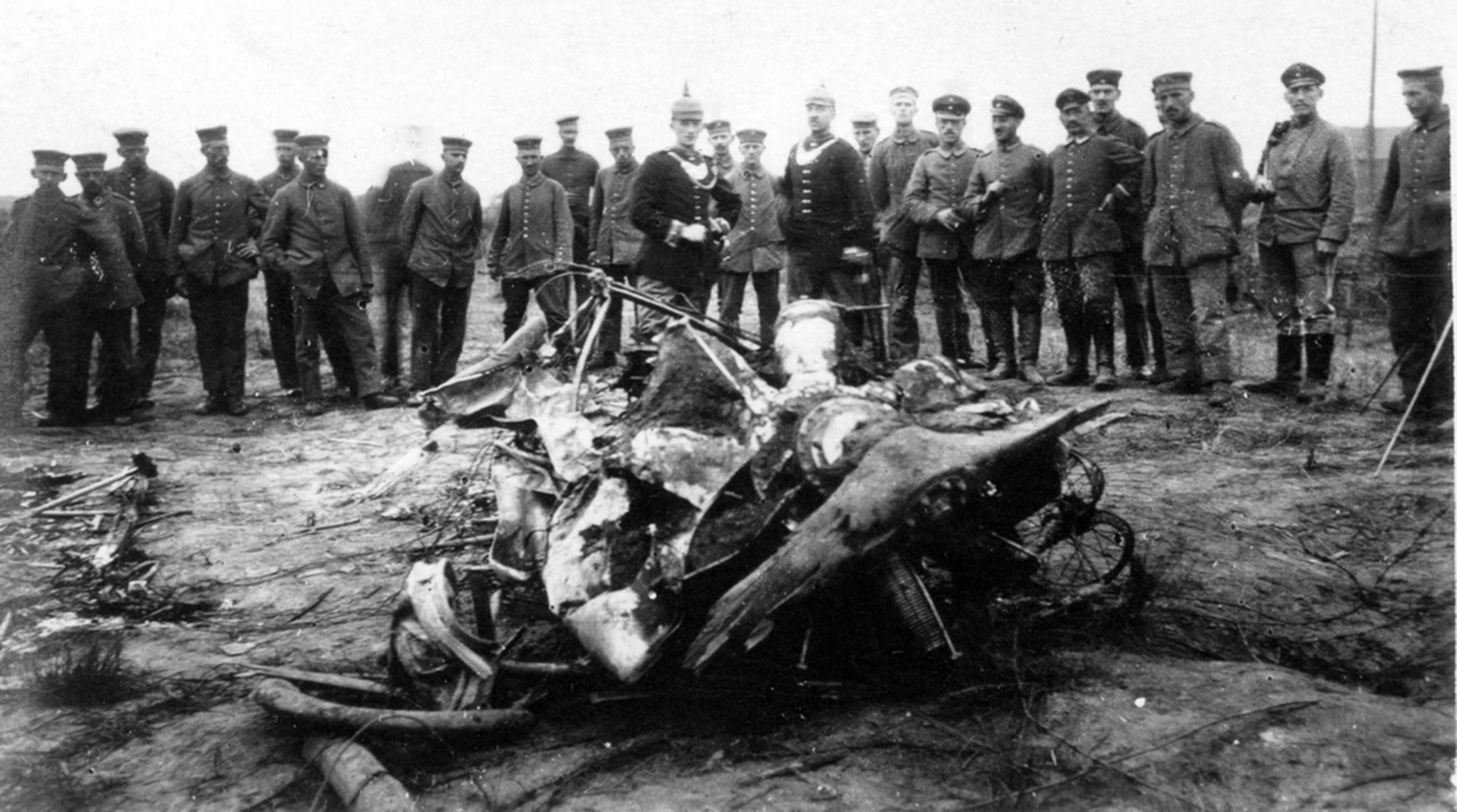

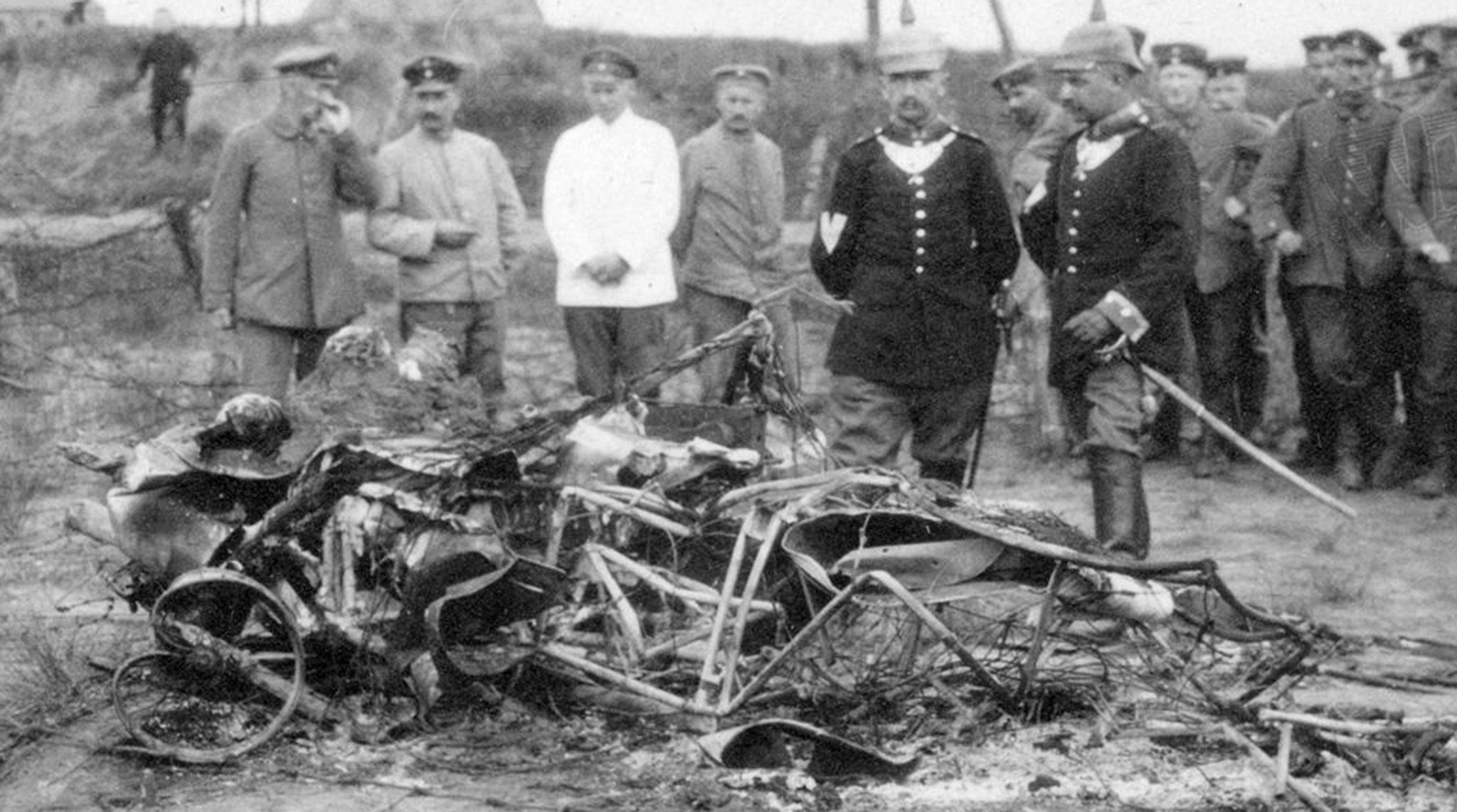
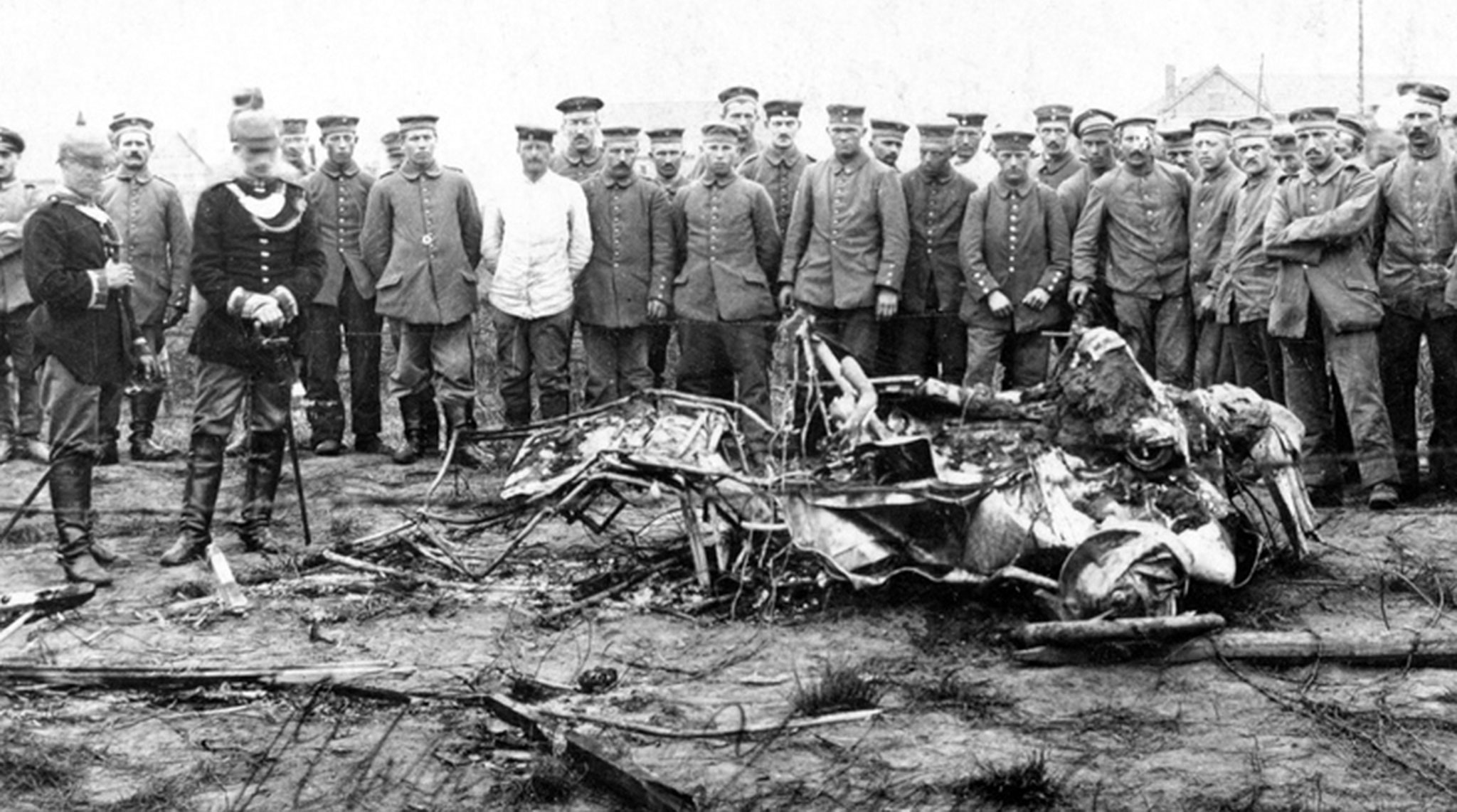
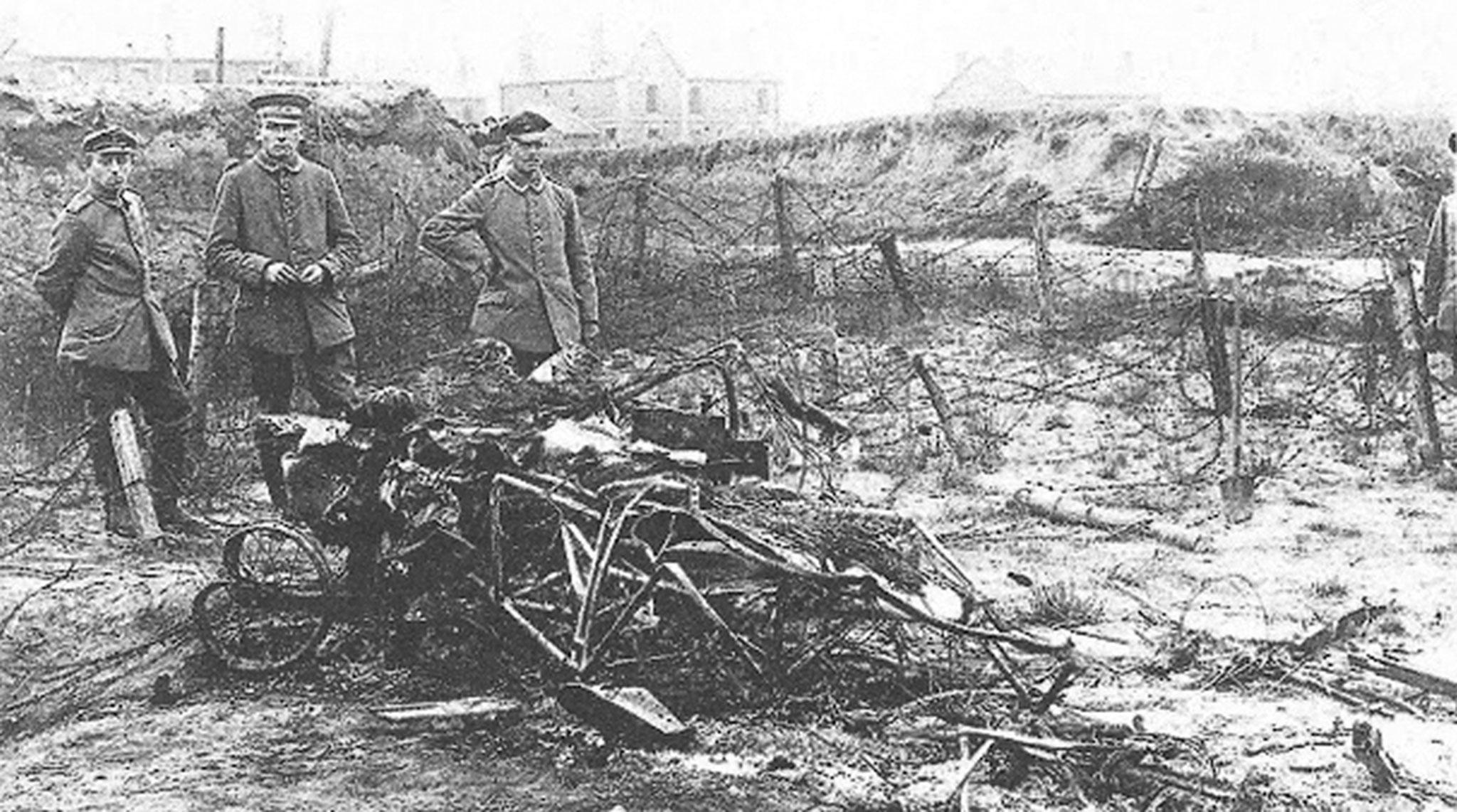
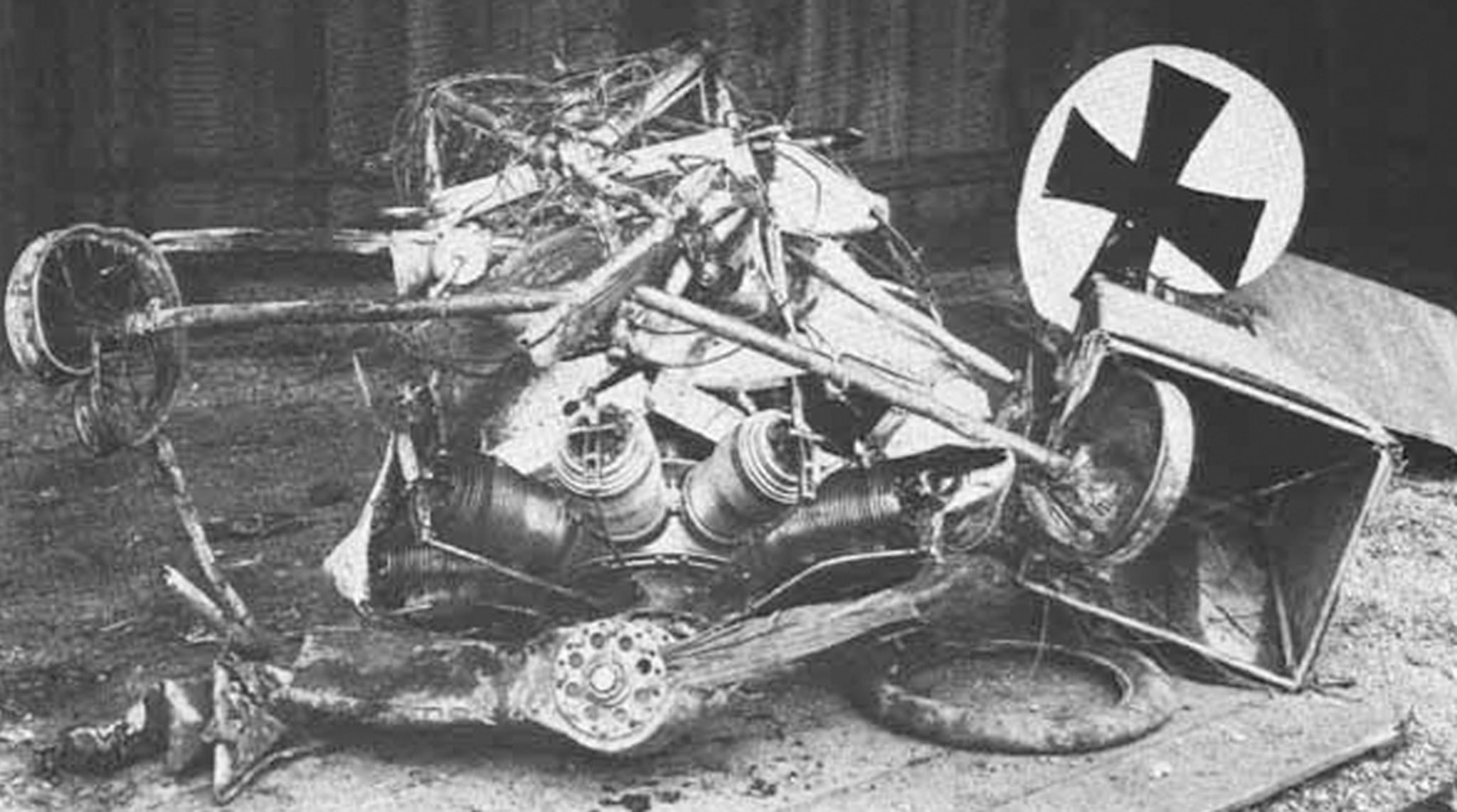
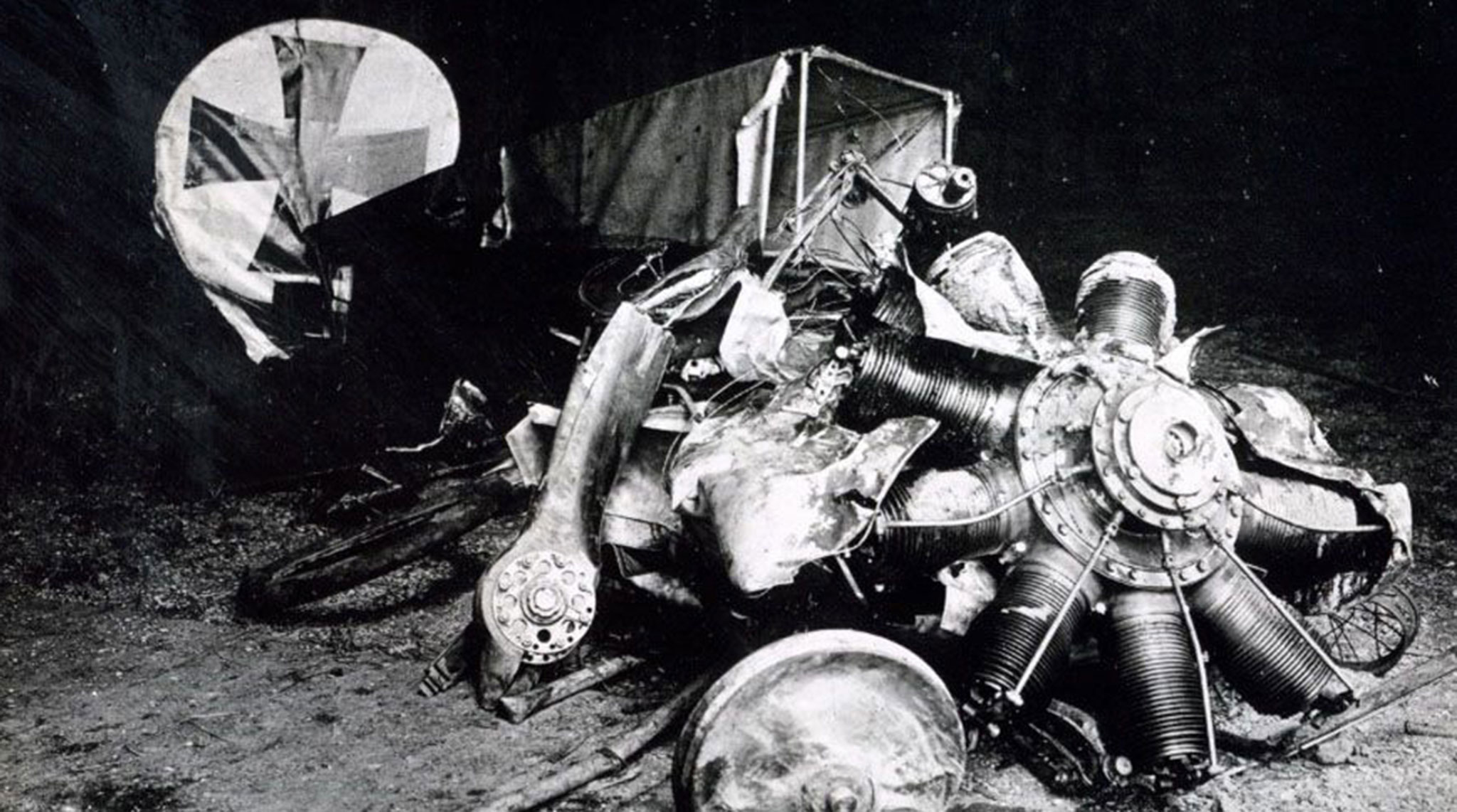
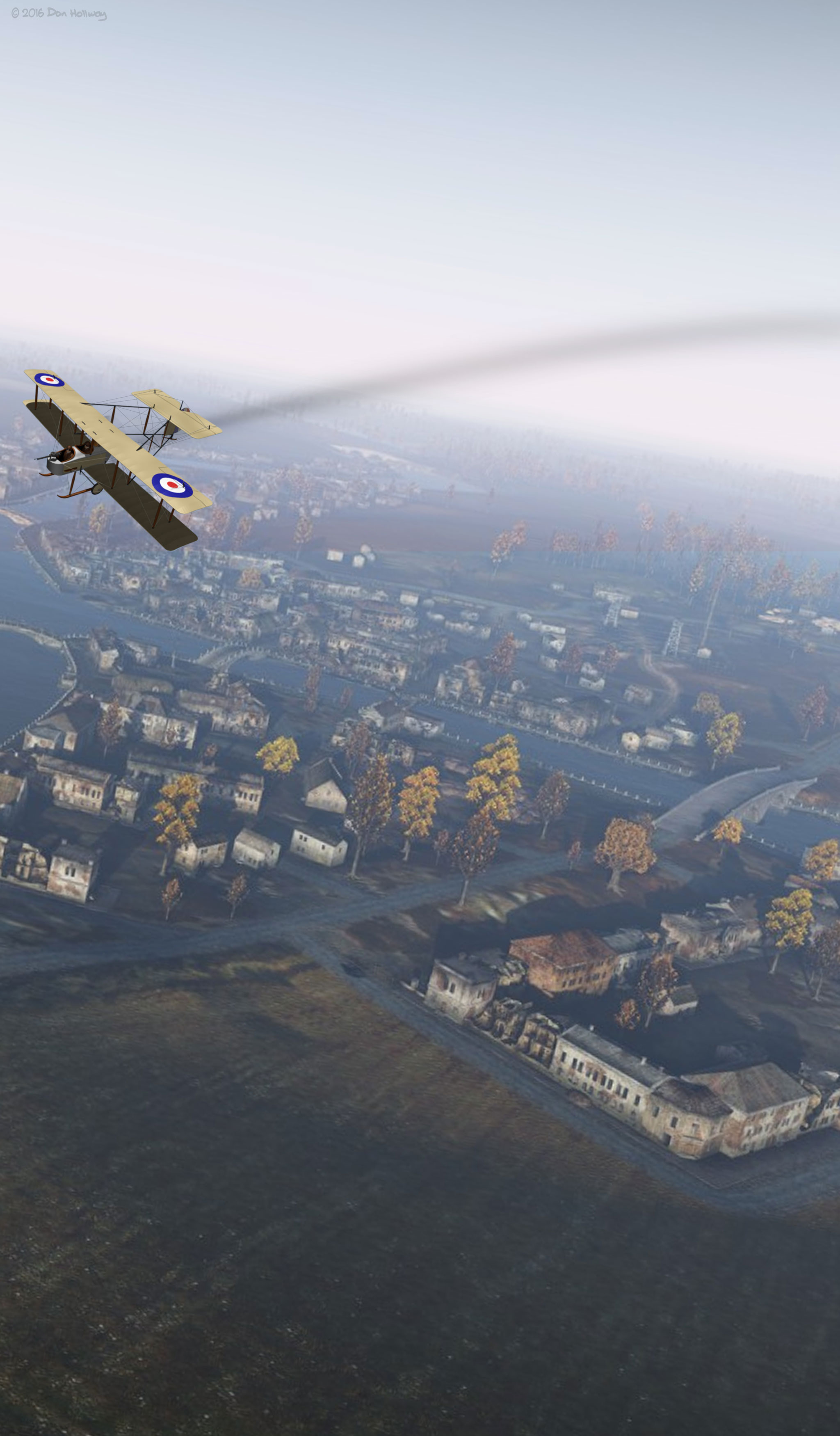
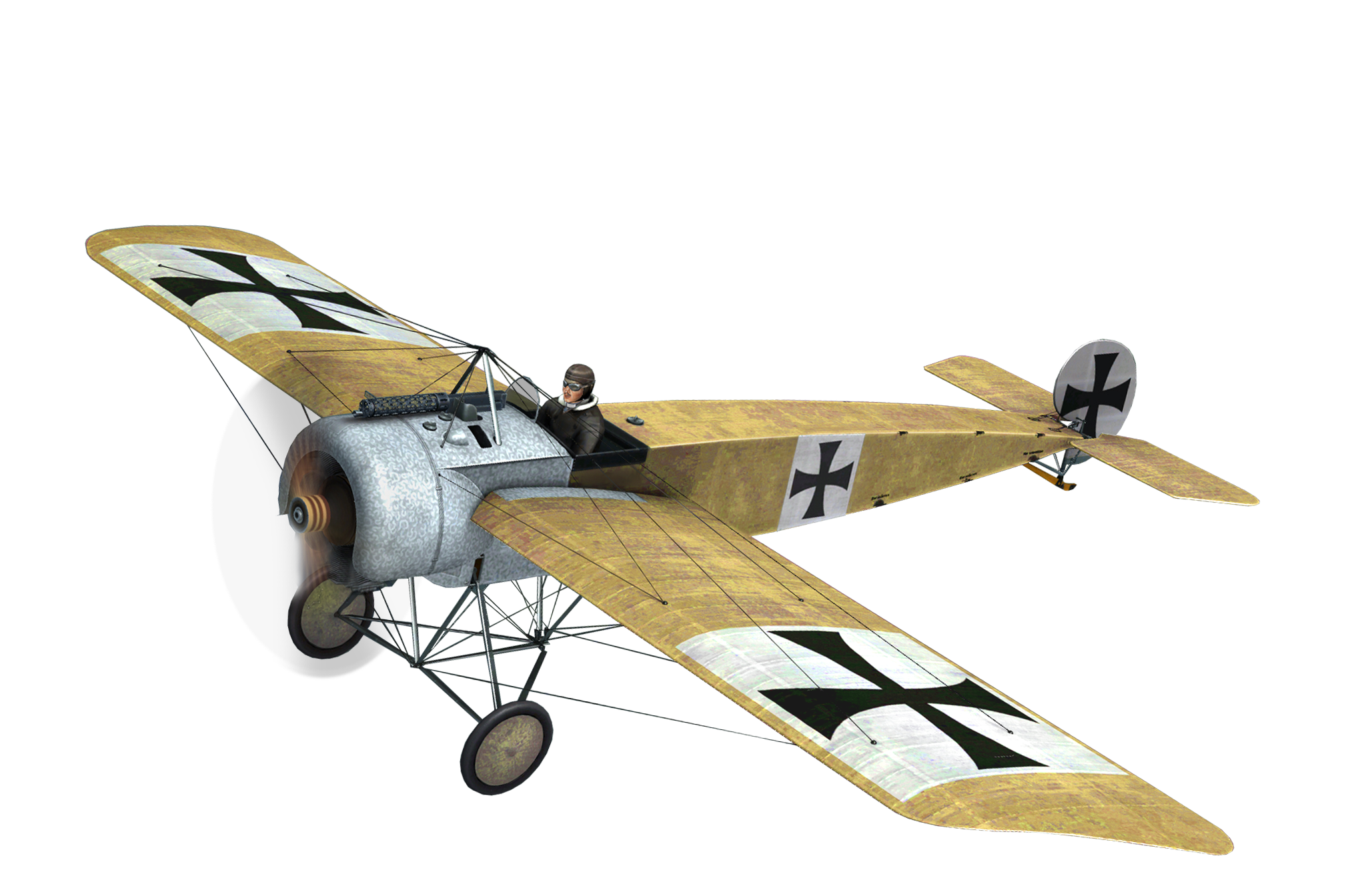
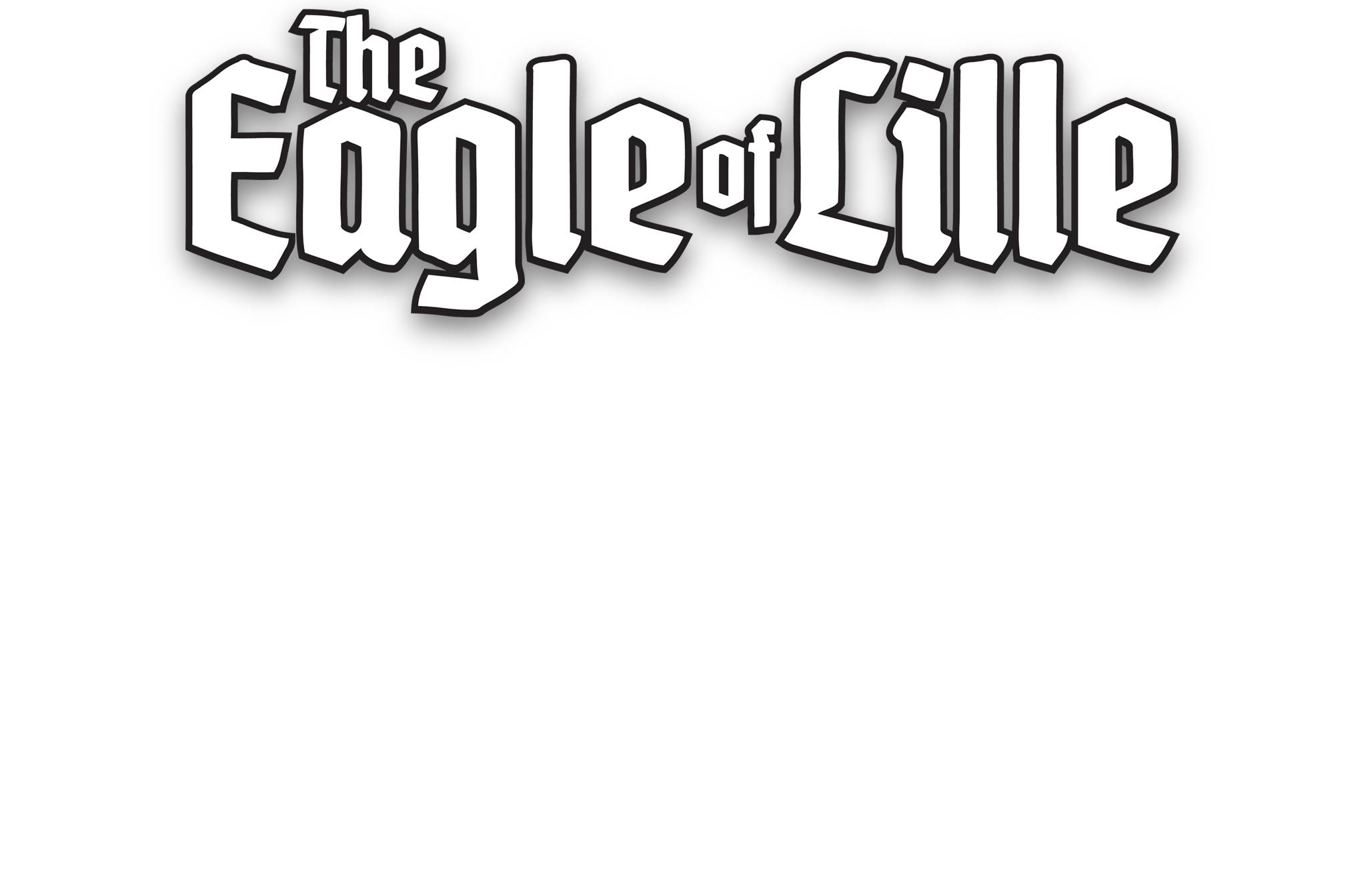
Approximately 10AM, October 26th, 1915: Over Cambrai, in Fokker Eindecker E.II # 37/15, Lt. Max Immelmann of FFA 62 forces down Vickers F.B.5 #5462 of No. 11 Squadron, RFC. PIlot Capt. C.C. Darley was wounded. Observer 2Lt R.J. Slade was unhurt. Both became prisoners. This victory, his fifth, made Immelmann an ace.
As a leader of Germany’s deadly “Fokker Scourge,” MaX Immelmann almost single-handedly took on the entire British Royal Flying Corps.
|
Originally published in the November 2013 issue of AVIATION HISTORY magazine. 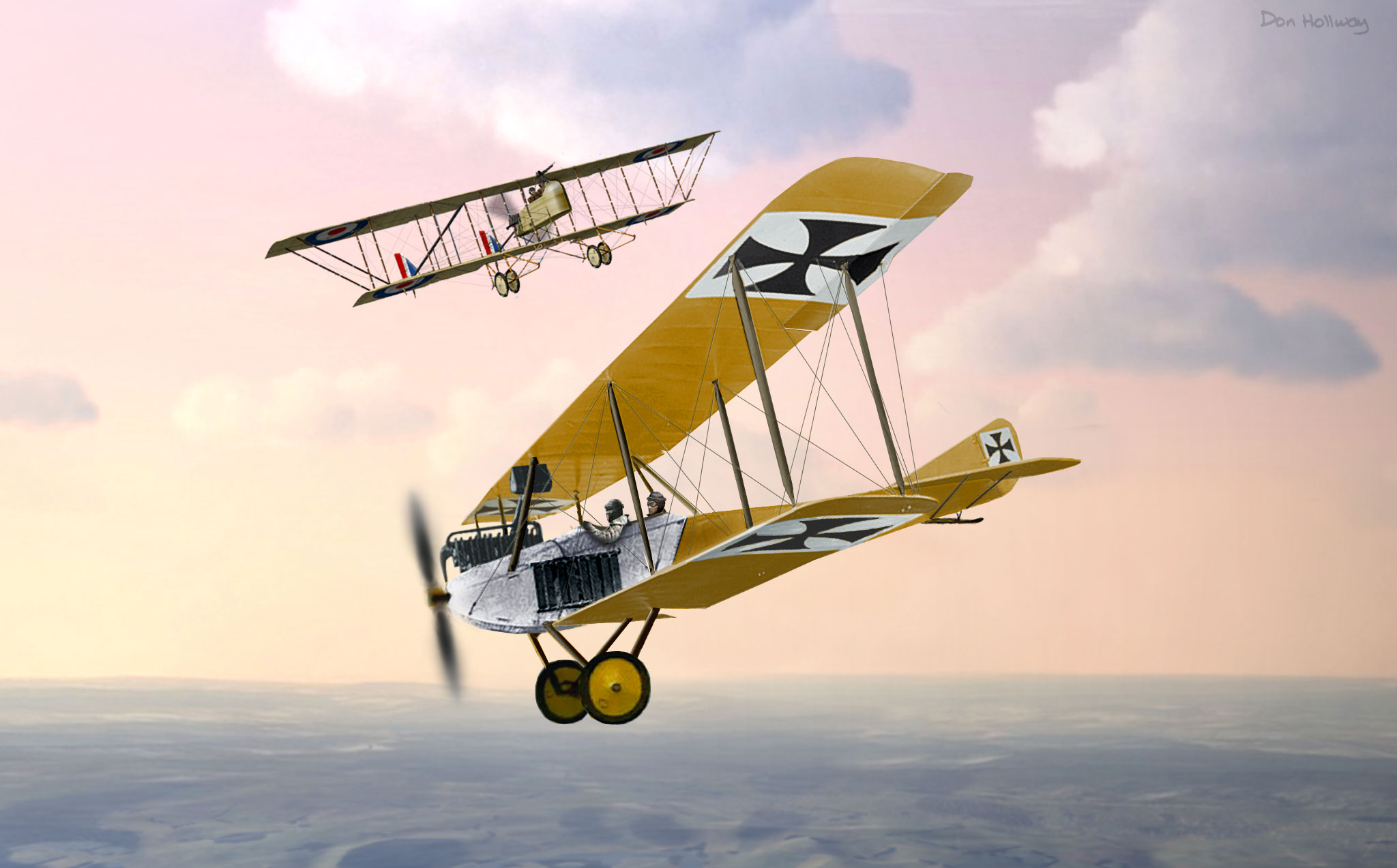
June 3rd, 1915: Over Arras, Ltn. Max Immelmann dives his unarmed LVG B away from an armed British Farman MF.11. Bundesarchiv footage of crew of a German LVG C.II at work, including a quick side attack by an Allied fighter, possibly Airco DH.2. (Silent) It didn’t take long for Ensign Max Immelmann of the Imperial German Flying Corps, piloting unarmed two seater reconnaissance planes over the Western Front, to learn that the enemy was shooting more than photographs. The Farman MF.11 diving at him during a June 1915 mission was already obsolete. Immelmann’s LVG B.I was a generation ahead—sleeker, faster, more powerful, higher flying. But the Farman had one thing the LVG didn’t: a machine gun. “Suddenly I heard the familiar tack tack tack tack...and saw little holes appear in our right wing,” recalled Immelmann, who held course for his observer to finish his photography until the enemy’s bullets began striking metal. “If the brute shoots up my engine, there is nothing more to be done!” 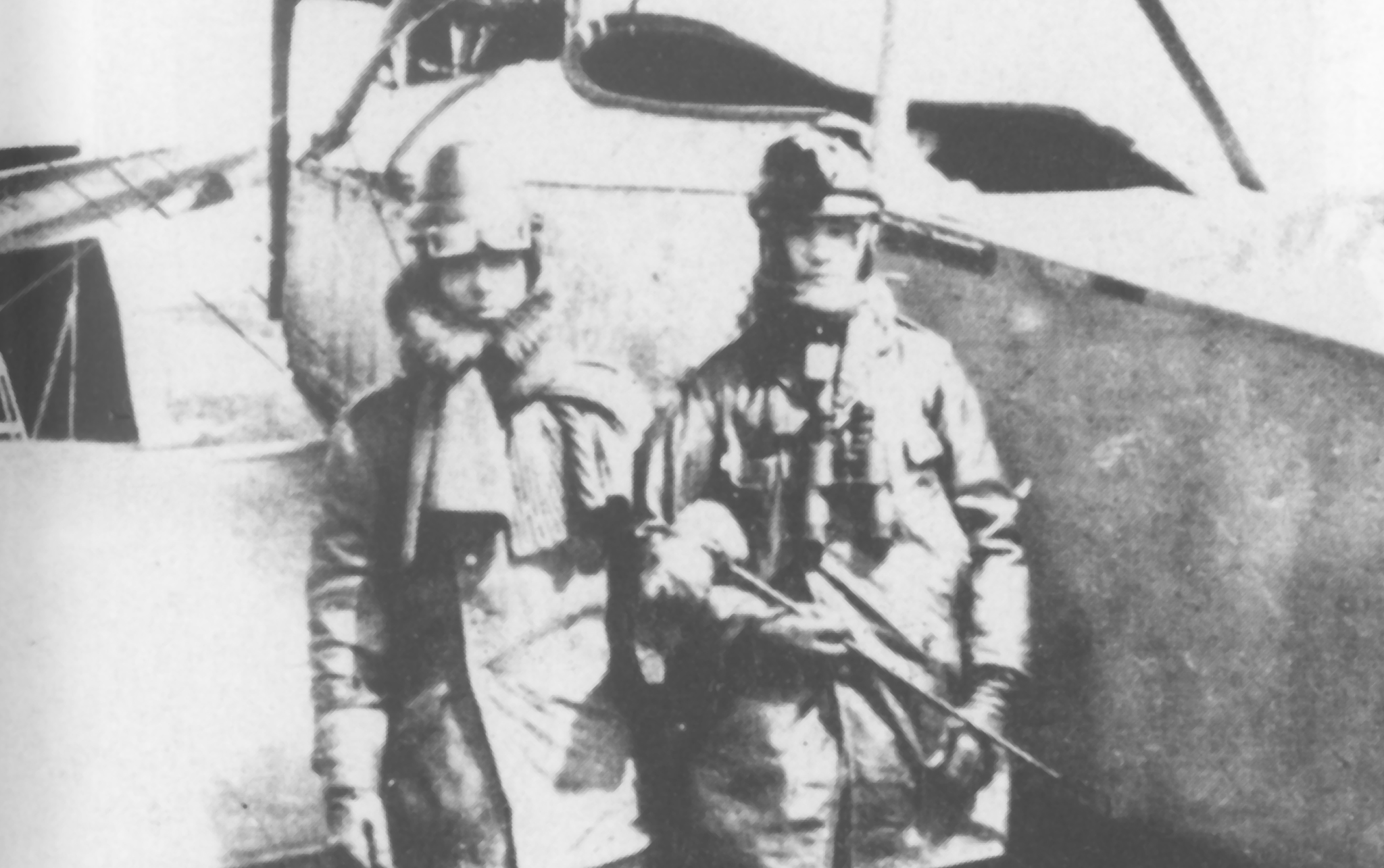
Ensign Max Immelmann (left) and his observer/gunner von Teuben with their LVG, after barely surviving their first air fight. Diving away, the German pilot nursed the LVG home to Douai. Squadron mates found one round had gone completely through its engine bed and another had nicked the main fuselage spar; had it broken, the whole plane would have folded up in midair. For saving his aircraft, Immelmann received the Iron Cross 2nd Class. He had also learned an important lesson: “It is a horrible feeling to have to wait until one is perhaps hit, without being able to fire a shot oneself!” 
Ltn. Max Immelmann with his mother Gertrude, sister Frida, and German mastiff Tyras. Photo may have been taken by his brother Franz. Max Immelmann was used to learning the hard way. His father, a Dresden manufacturer, died when he was just 7. His mother raised him to be a vegetarian, nonsmoking teetotaler. A squadron mate later recalled that “in the field he did eat meat, although his real love was ‘mountains of excellent cake’ which he bit into each afternoon.” Such habits did not necessarily endear Immelmann to military comrades. His best friend may have been his gray German mastiff Tyras, who slept in his master’s bed. “Of course the brave doggie must go to war with me, and he’s already delighted with the idea!” he wrote home in the first weeks of the war. “He has got a label on his collar, inscribed: ‘War Dog.’” His letters also show an early affinity for a fellow Saxon in Feldflieger Abteilung (Flying Section) 62. Eight months younger than Immelmann, 24-year-old Lieutenant Oswald Boelcke was by that time a veteran of more than 50 missions who had already received the Iron Cross 2nd Class. “We suit one another very well,” Immelmann wrote. “[Neither] of us smoke, and we practically never touch alcohol....He has been flying since the beginning of the war and spent a long time at the front.” In July 1915, when FFA 62 got its first armed two seater, an LVG C.I with a parabellum MG14 for the observer, it was assigned to Boelcke. Immelmann and his backseater mounted a captured French machine gun on their LVG. “Although my ‘auxiliary fighter’ is only a makeshift, at least my observer can rattle away with his gun, and that makes a permanent impression on the French,” he wrote. “Things are going to be different now.” On July 4, Boelcke and his observer scored the section’s first kill, a Morane Saulnier L two seat Parasol monoplane. Later that month, however, the squadron took delivery of a pair of new Fokker E.I Eindecker single seat scouts. No mere weapon-hauler, the Fokker had a machine gun fixed to the cowling and synchronized to fire between the prop blades. “These little craft absorb my entire interest,” Immelmann enthused. “They are pretty machines, and they are light, speedy and nimble. The pilot flies alone. The machine is designed solely for fighting enemy airmen, and not reconnaissance work.” 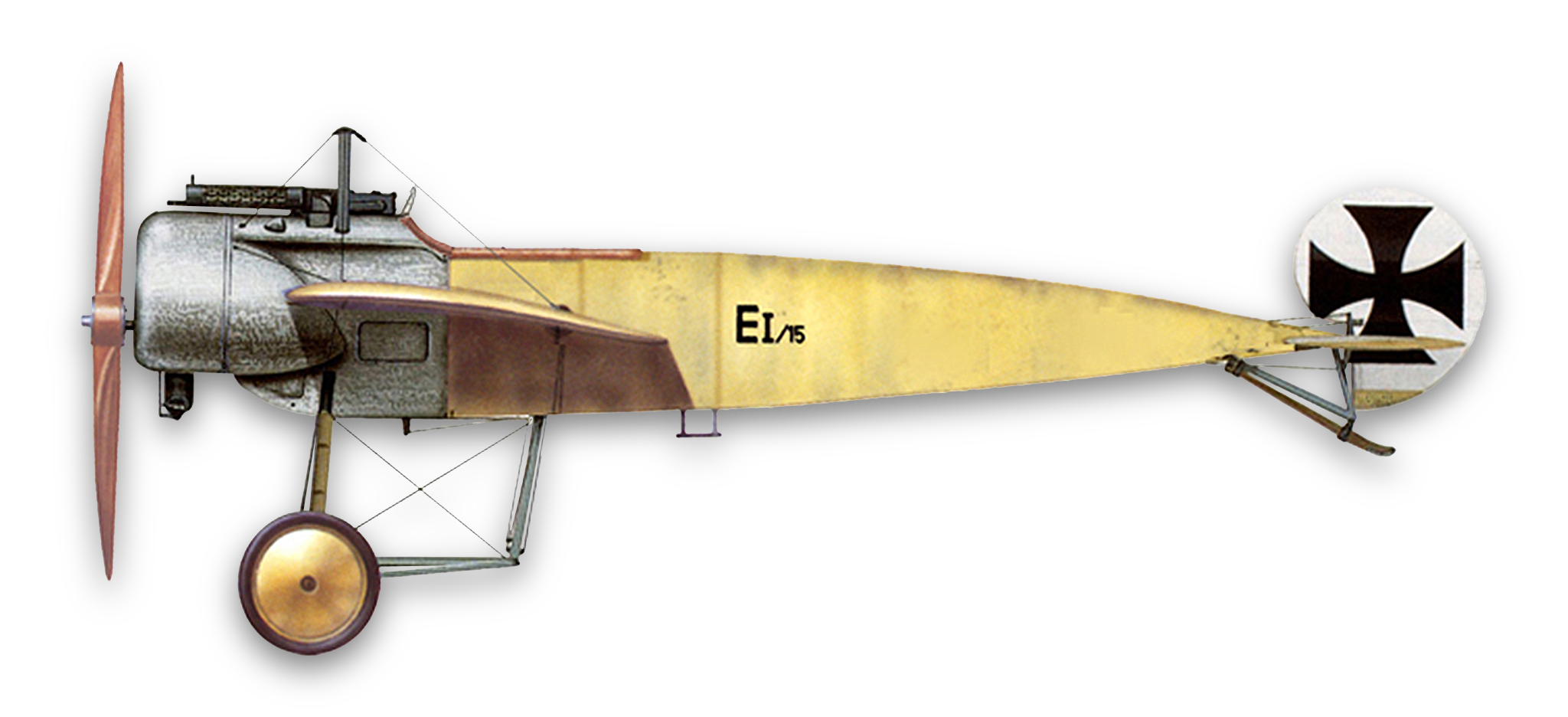
Fokker E.I /15 E.I/15 was the first Eindecker in combat, flown by both Boelcke and Immelmann He practiced his gunnery using ground targets until August 1, when British B.E.2c bombers hit Douai at dawn. Boelcke was first to take off in pursuit, with Immelmann hot on his tail. “There were at least ten enemy machines in the air,” Immelmann recalled. “Suddenly I saw Boelcke go down in a steep dive. As I learnt later, he had a bad gun stoppage, so that he couldn’t fire a shot.” Boelcke could only return to Douai, where he warned everyone, “They will shoot our Immelmann dead!” 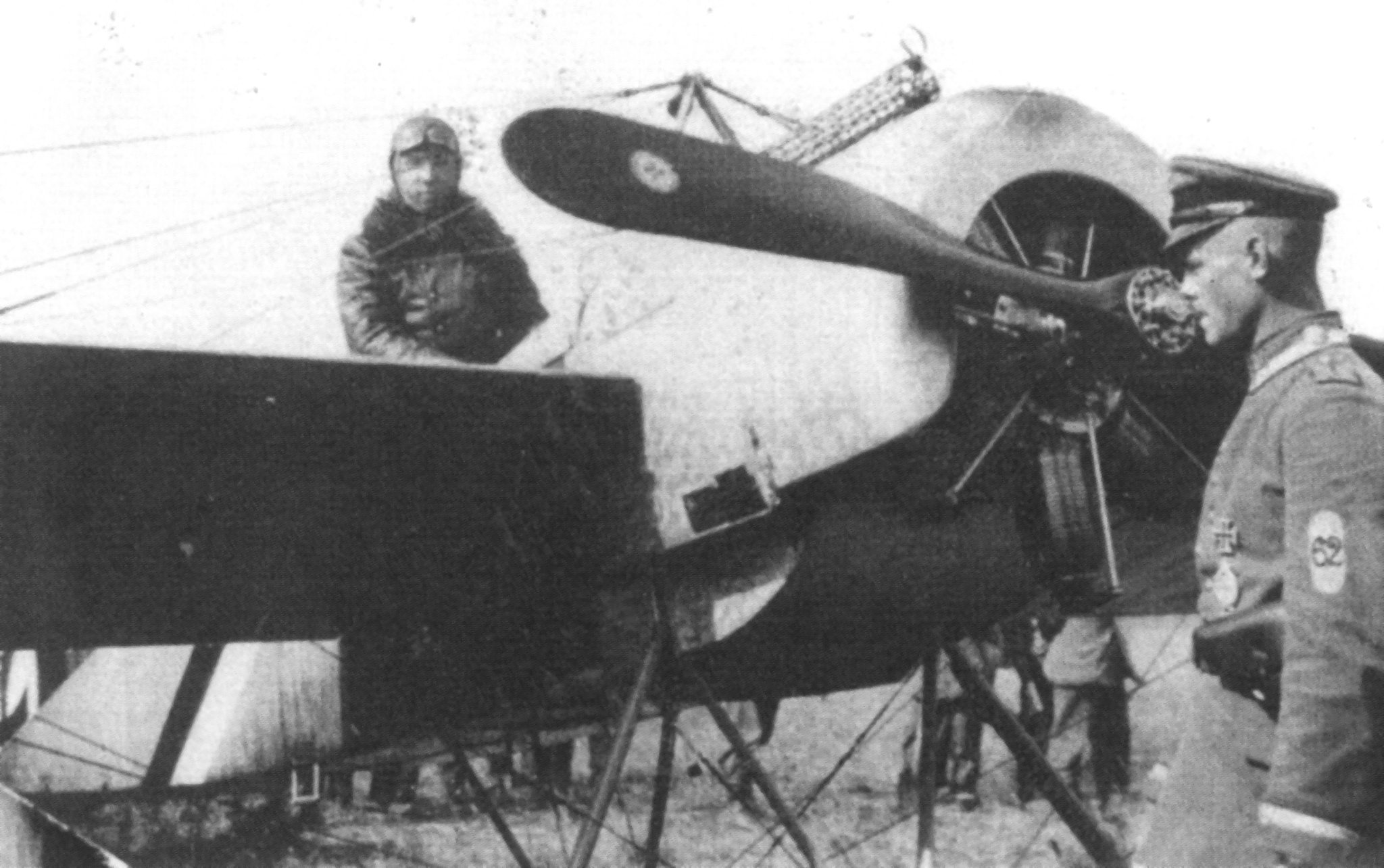
Immelmann in the cockpit of an Eindecker E.I, probably #13/15, in which he scored his first five victories. Powder burns at the top of the cowling indictate the gun has been fired. Of interest are the white/black fuselage stripes denoting FFA 62, the squadron insignia on the airman’s sleeve and, on the prop, the insignia of the manufacturer Garuda. More But Immelmann had caught up with a B.E.2c halfway back to Arras. “I dived on him and fired my machine gun,” he recounted. “For a moment I thought I was going to fly right into him.” Canadian pilot Lieutenant William Reid had used his observer’s seat to store bombs, and had only a handgun to defend himself. Immelmann’s machine gun repeatedly jammed, and he had to use both hands to clear it, even as he maneuvered to cut off Reid’s escape and dodge enemy fire. The men at Douai watched the whole thing. Immelmann said they later told him that “my turns and glides and my flying in general looked as if I had been in a Fokker for weeks instead of three days.” After some 10 minutes and 500 rounds, Immelmann’s gun either failed completely or simply ran dry. Reid, wounded, coasted down behind German lines. Immelmann landed to take him prisoner. Awarded the Iron Cross 1st Class, he took advantage of his newly won prestige to write Tony Fokker, claiming precedence over Boelcke in receiving the first new Eindecker E.II. The two friends had become rivals. 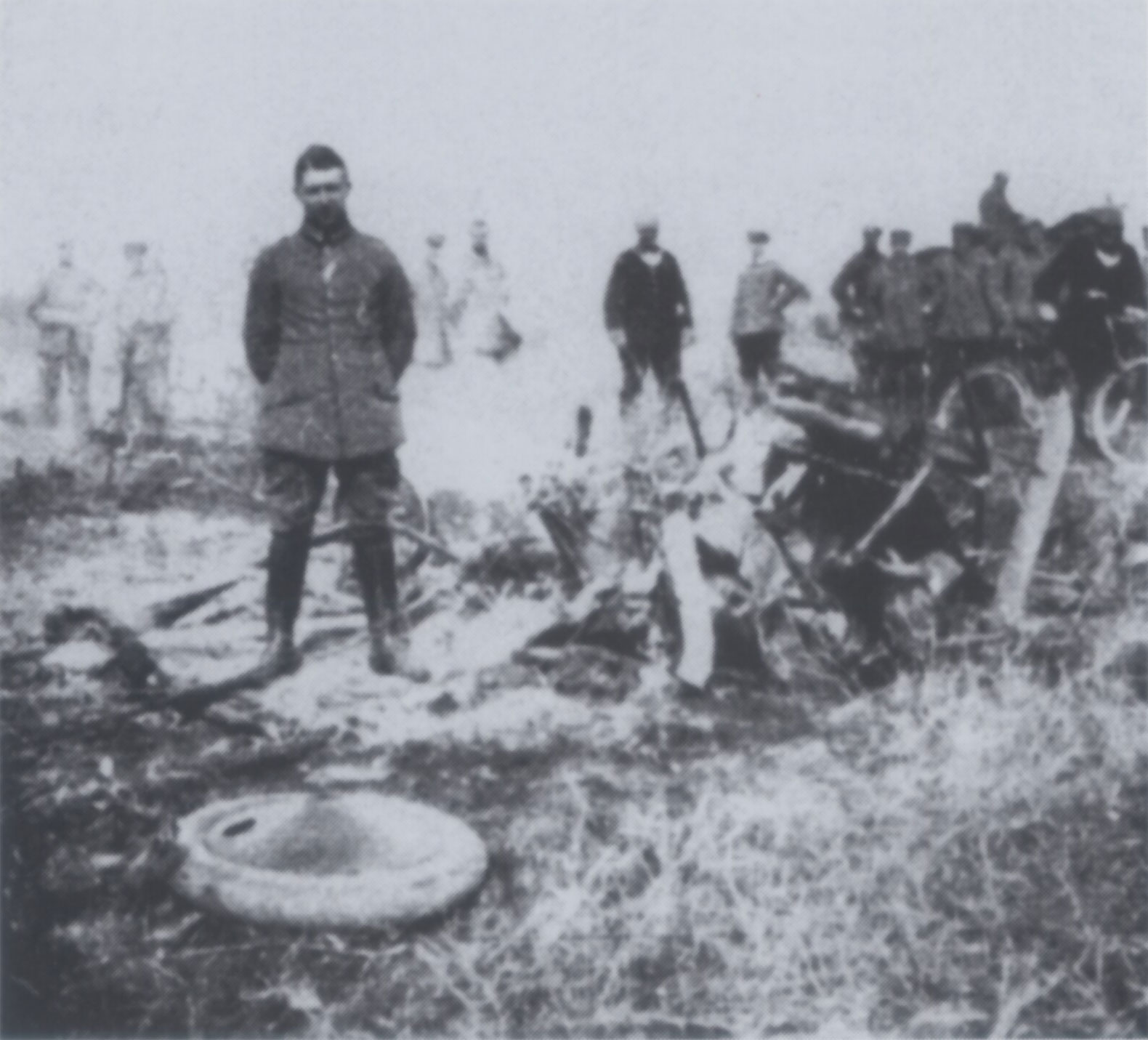
Immelmann with remains of his third kill, a B.E.2. shot down over Neuville on Sept. 21, 1915—Immelmann’s 25th birthday. Observer Lt. William Sugden Hodgson-Wilson was wounded. Pilot 2/Lt Stanley Winther Caws was killed. 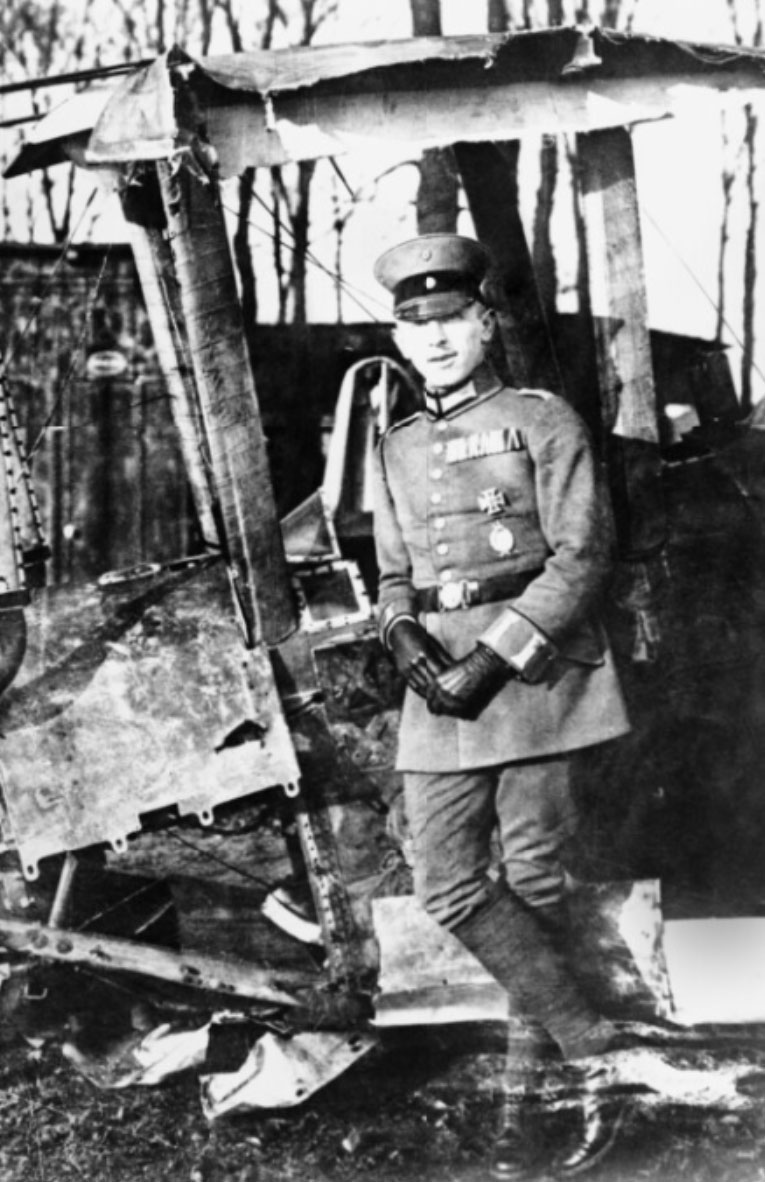
Immelmann with the wreckage of his fourth victory, No. 16 Sqn. Royal Aircraft Factory B.E.2 #2005, shot down over Lille at 3PM on Oct. 10, 1915. Observer Lt. Thomas David Leeson suffered a light leg wound. Pilot 2Lt. John Gay was hit six times and later died. See also this view and rare, brief film footage. It took Boelcke more than two weeks to get his second kill, but Immelmann needed only a week after that to catch up. The two were flying an evening patrol over the lines on August 26. “Suddenly I saw an Allied biplane attack Boelcke from behind,” Immelmann wrote. “Boelcke did not seem to have seen him.” Immelmann broke up the enemy’s pass, and Boelcke came around. “First he came into Boelcke’s sights, and then into mine, and finally we both went for him....Boelcke’s gun appeared to have jammed, but I fired 300 rounds.” The enemy pilot threw up both arms and Immelmann saw his helmet come off, just before the plane plummeted 7,200 feet to the ground. Boelcke returned the favor on September 9, shooting a Morane Saulnier off Immelmann’s tail for his third victory. In those early days of aerial combat, these were likely the first recorded instances of leader/wingman tactics. But who was the leader, and who was the wingman? 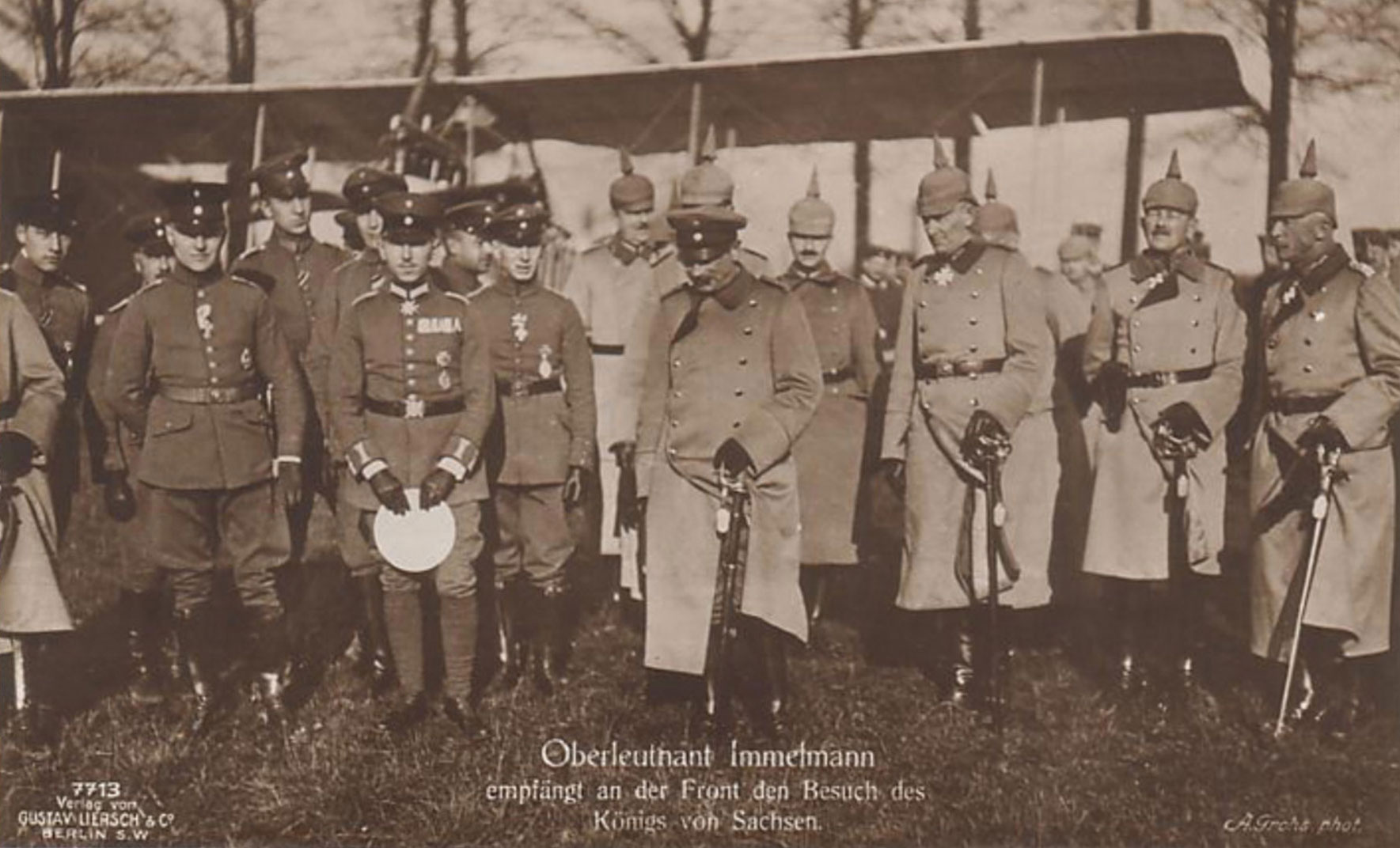
15 Nov. 1915. Immelmann holds the plate of Meissen porcelain with a scene of an air battle, awarded to him by Frederick Augustus III, King of Saxony (center). (The King was inspecting FFA 24 at Lille.) The medal at his throat is not the Pour le Mérite, but the Knight’s Cross of Military Order of St. Henry. He was eventually awarded the Commander’s Cross 2nd Class, the only airman to receive it. 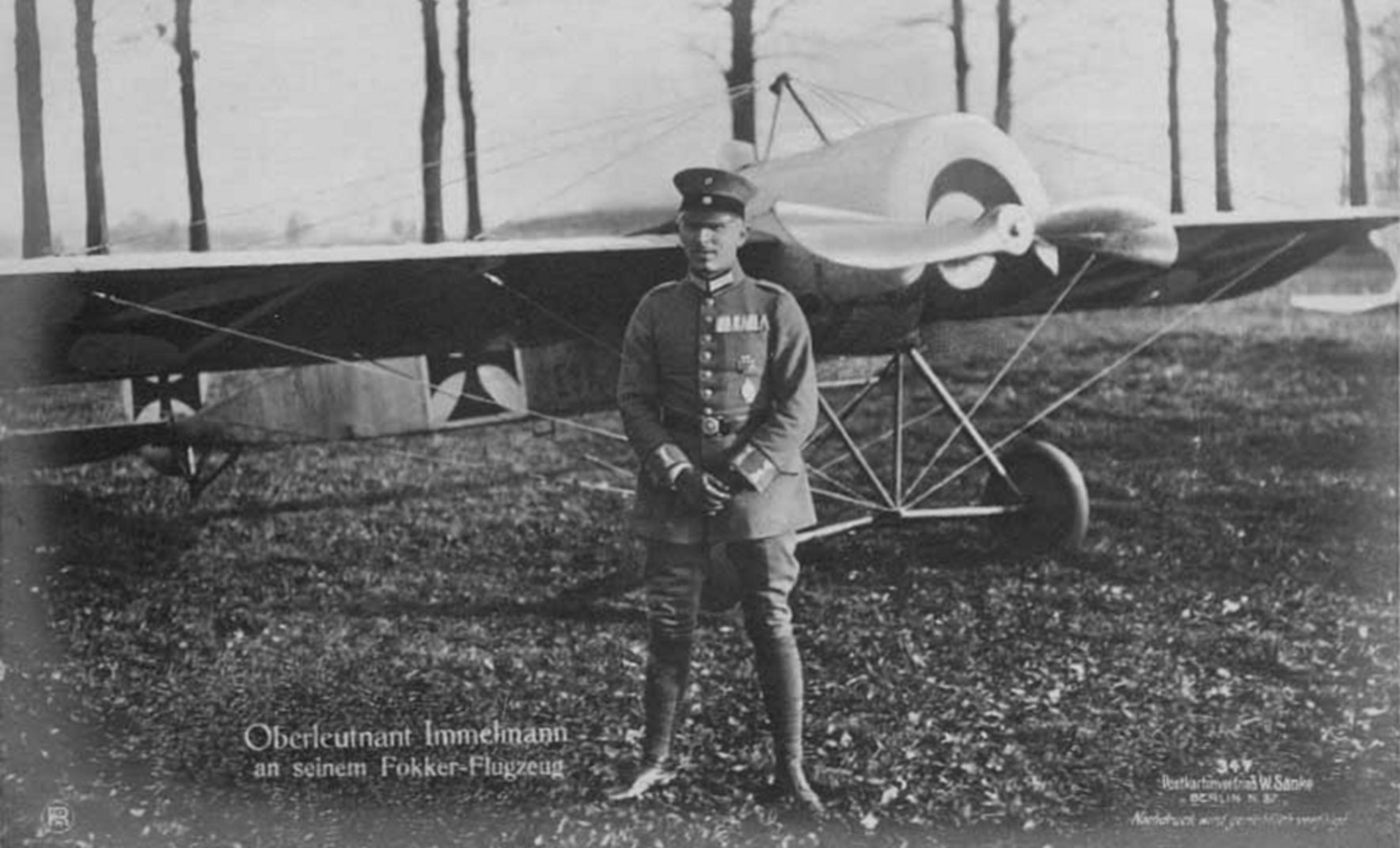
Immelmann with Fokker E.II #37/15. This photo was taken during his demonstration flight for King Friedrich August III, and according to Immelmann’s memoirs may have been taken by the king himself. Note how armamaent and details of cowl, engine and cockpit have been airbrushed by the military censor. 
By the end of October, Immelmann had scored his fifth victory, a Vickers F.B.5 “Gun Bus,” and had received mention in military communiqués. “Now I shall no longer object to being written up in the papers, since I have seen how everyone at home follows my successes,” he wrote. His newfound fame was spoiled only by the fact that Boelcke still ran neck and neck with him. “He claims to have shot down five enemy machines, but one of them landed on its own territory,” groused Immelmann. “If I counted all those, I should have at least seven.” 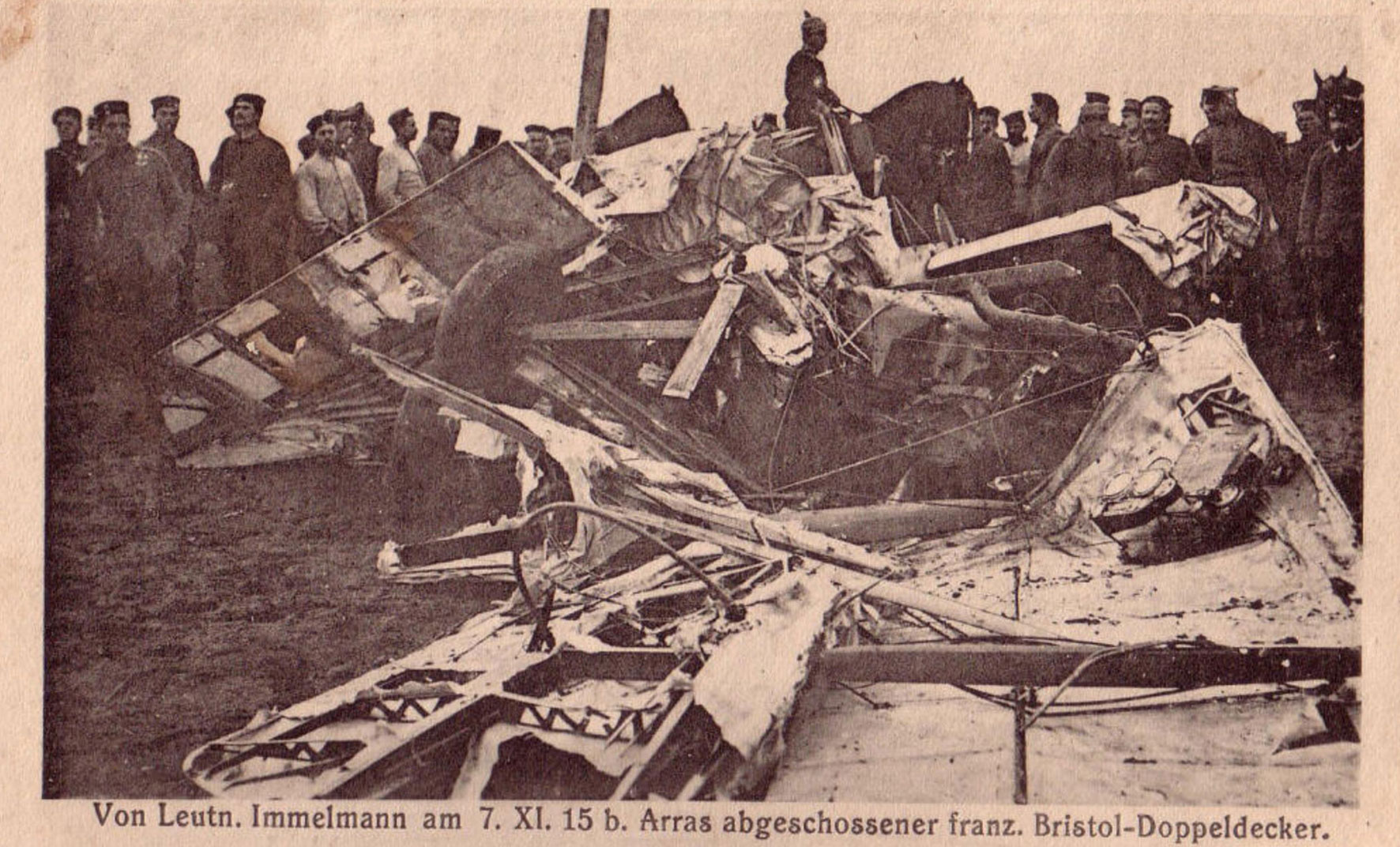
6th victory. A BE2C #1715, shot down west of Lille on the afternoon of 7 November 1915. Lt. Owen Vincent LeBas, observer, and Capt. T.D. Adams were killed. Immelmann landed nearby and pulled the dead men from the plane himself. 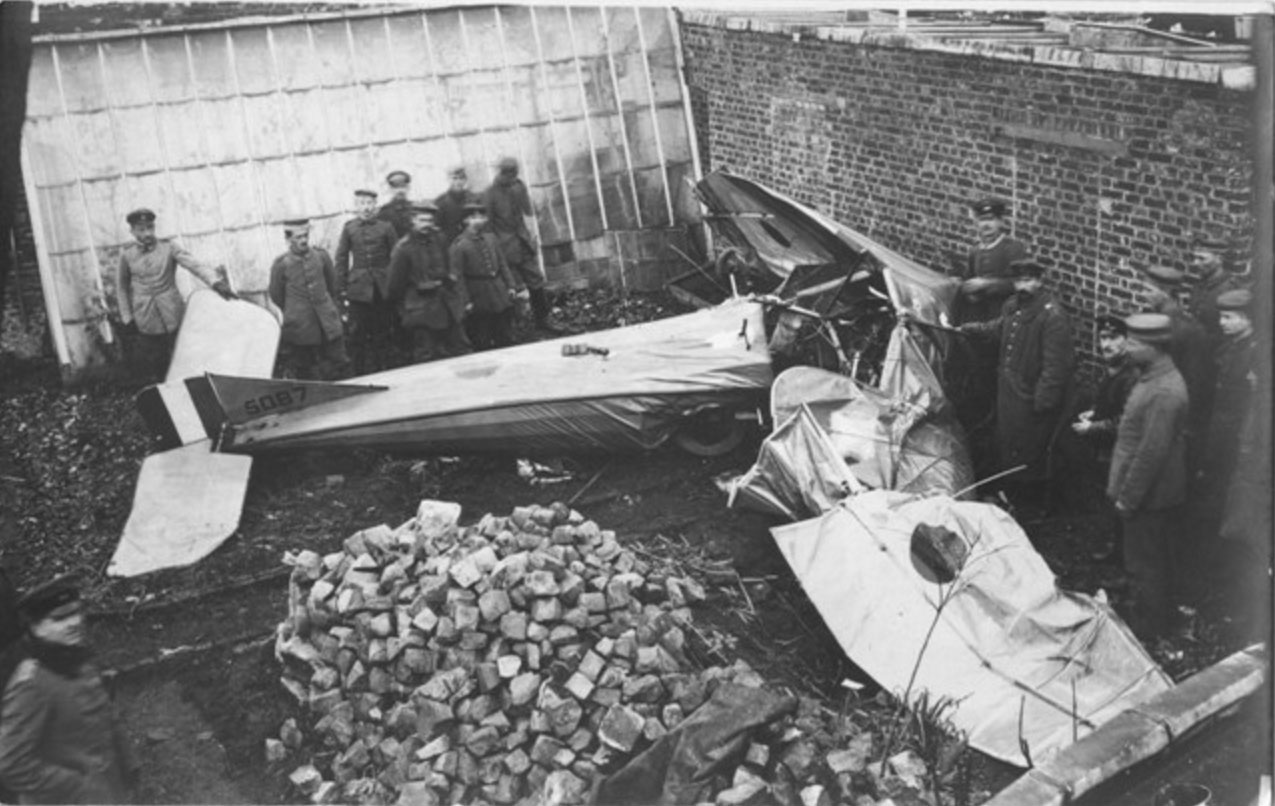
7th victory. Morane-Saulnier L “Parasol” #5087 of No. 3 Sqn., shot down near Valenciennes on the morning of 15 Dec 1915. Lt. Alan Victor Hobbs and Lt. Charles Edward Tudor-Jones were killed. More 
By January 1916, Immelmann had seven victories confirmed. On the morning of the 12th he dived head on at a Gun Bus about 9,000 feet above Bapaume. The initial pass devolved into a turning fight in which the Eindecker had the upper hand. Immelmann put more than 100 rounds into the Vickers. “All of a sudden a reddish yellow flame shot out from his engine, leaving a long trail of smoke behind him.” Though he was wounded and his observer dead, British pilot 2nd Lt. Herbert Thomas Kemp managed to land his blazing ship and jump clear. Immelmann set down nearby, and the two of them watched the Vickers burn. “You are Immelmann?” Kemp asked him. “You are well known to us. Your victory today is another fine sporting success for you.” 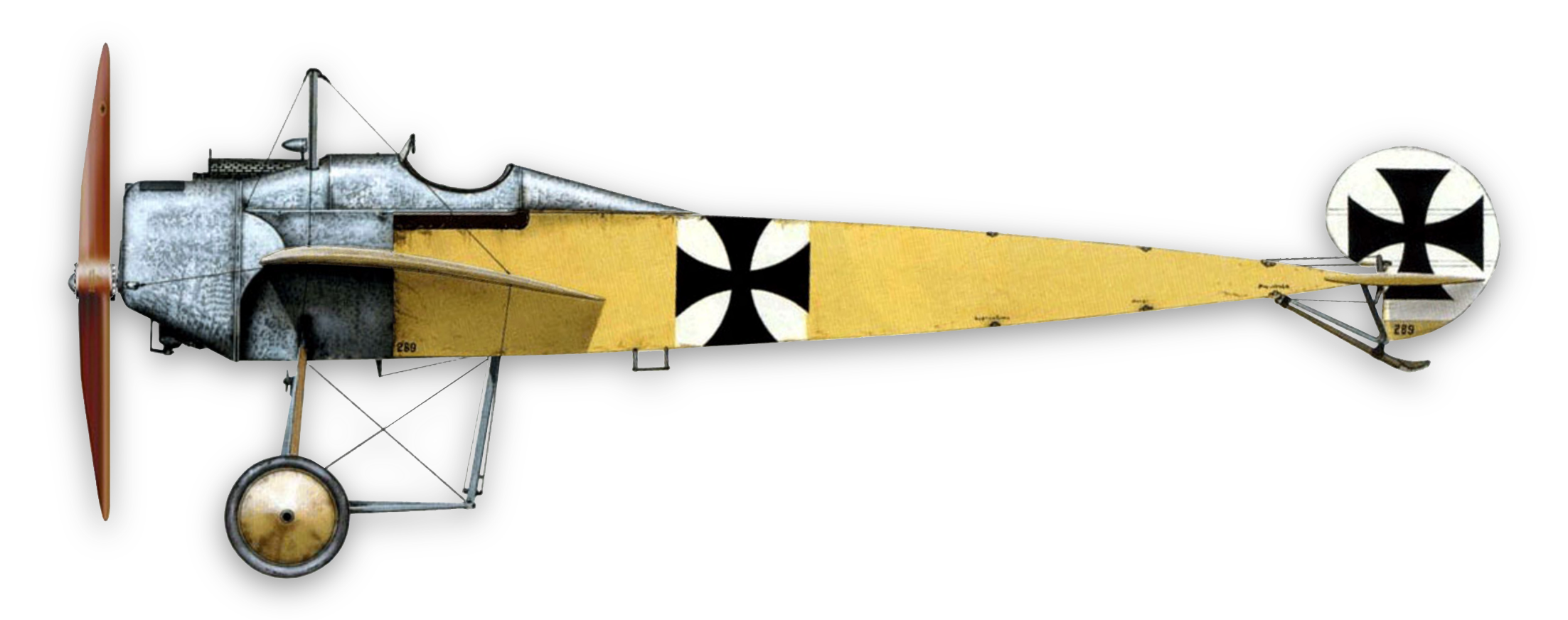
Fokker E.IV 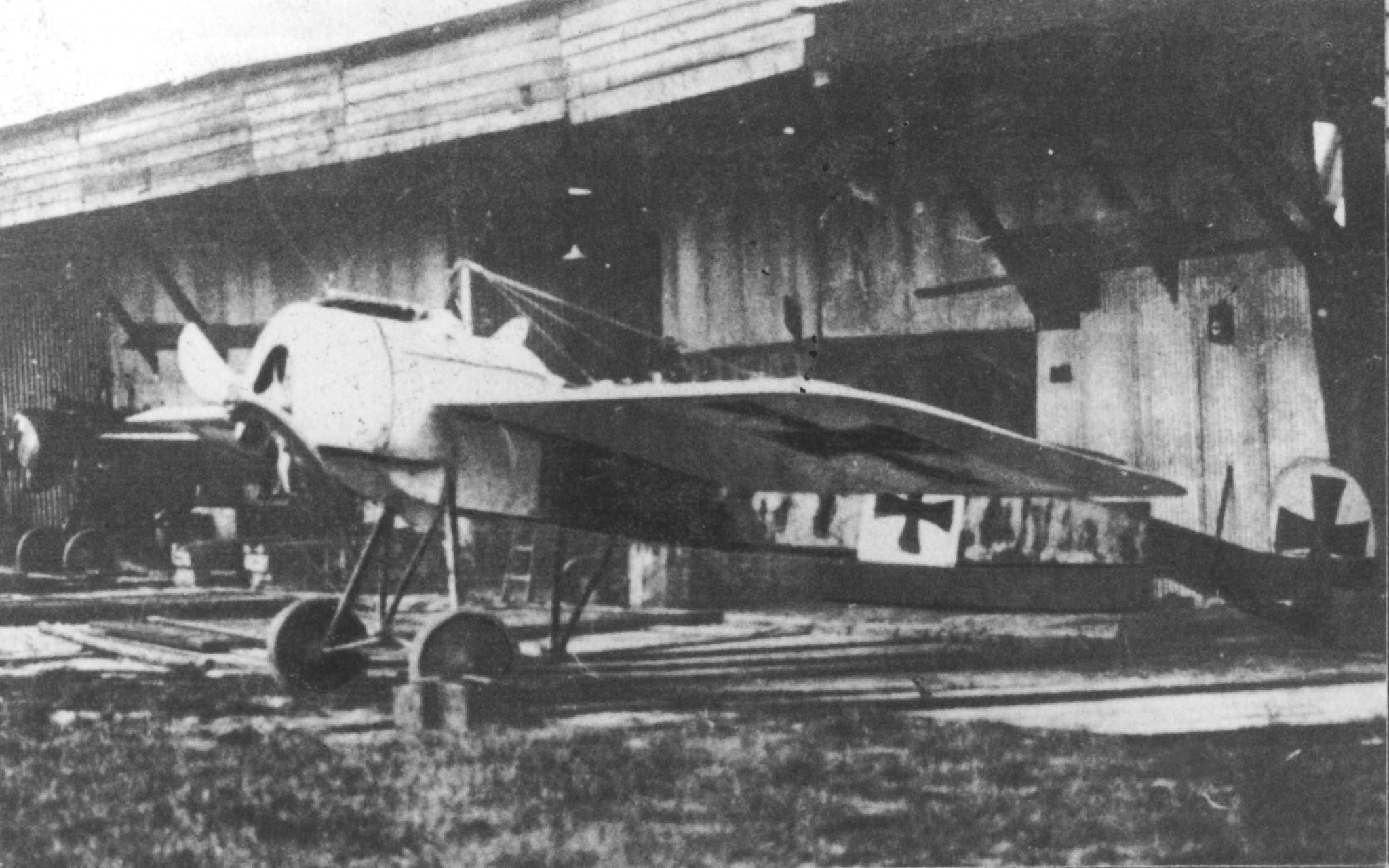
Fokker E.III, thought to be Immelmann’s, as is the E.IV just visible at left. This photo can definitely be associated with another rare shot of Immelmann, as the dogleg marks and dark boards in the planking at top are identical. If Immelmann then fancied himself the top German ace, it was only until his return to Douai, where he learned Boelcke had also scored his eighth shootdown at almost the same hour. Nonetheless, he commented, “I was never so pleased at one of Boelcke’s victories as I was that day.” At mess the section commander announced, “His Majesty the Emperor has been graciously pleased to confer the highest war order, the ‘Pour le Mérite,’ on the two victors in aerial warfare.” Later in the war, as dogfights became more common, winning the Order required up to 20 victories, but Immelmann and Boelcke were the first aviators and junior officers so honored, and on the same day. (The story goes that Immelmann was decorated first, which is why the Pour le Mérite isn’t nicknamed the “Blue Oswald.”) To top it off, a few days later Immelmann received a new Eindecker E.IV—bigger and heavier, with a twin row 160-hp Oberursel radial engine and twin machine guns. He was now one of the world’s top scoring fighter pilots, flying the world’s top combat aircraft. 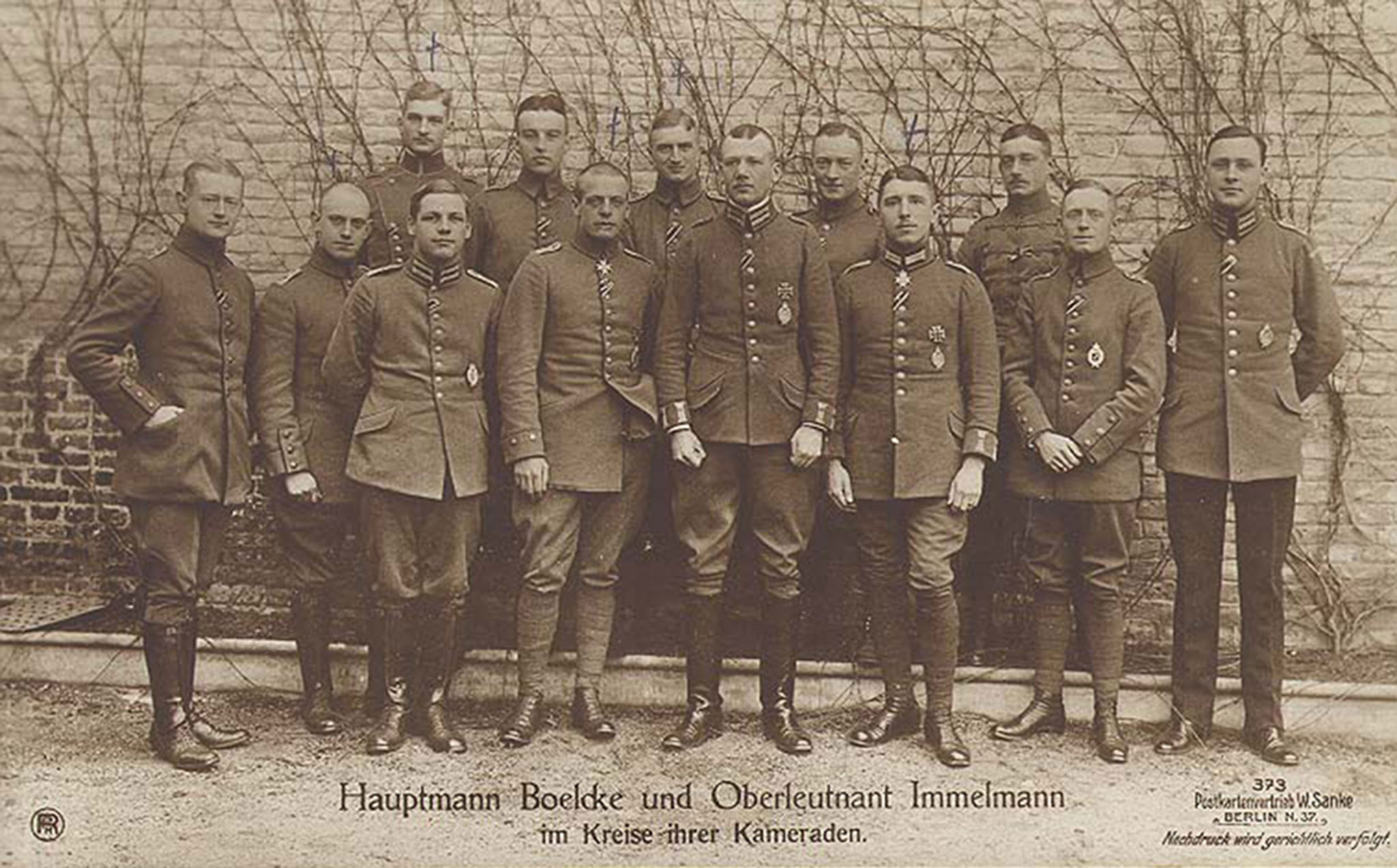
The Fokker Scourge:
Front row, L to R: Ltn. Gustav Salffner, Meding, Ltn. Albert Oesterreicher, Ltn. Oswald Boelke, commanding officer Hauptmann Hermann Kastner, Ltn. Max Immelmann, von Krause, Ltn. Ernst Hess. Boelcke and Immelmann wearing the Pour le Mérite Boelcke, whose fame would eventually rest on his Dicta, the rules of air combat and unit tactics that he authored, would subsequently do much of his fighting against the French over Metz and Verdun. The air war against the British, over Lille, would be led by Immelmann and his Eindecker. More of a loner, he gained fame because he was feared, even though he seems to have been an indifferent shot and, in a dogfight, not so much skilled as persistent. He once wrote, “I do not employ any tricks when I attack,” and never claimed to have performed the “Immelmann Turn,” much less ever took credit for it. A climbing half loop with a roll out at the top (but in the low powered planes of the day, probably more of a wingover), the maneuver may have been named after Immelmann by British pilots, as a means of escaping him. He and Boelcke led the “Fokker Scourge,” making “Fokker Fodder” of Allied airmen, but since he scored no confirmed kills from early January through early March 1916, it could be said that Immelmann, the “Eagle of Lille,” owned his piece of the sky largely by reputation. “[Enemy airplanes] never come to Douai now, except sometimes in formations of ten,” he wrote in early February. “It has been said in the House of Commons and in a French meeting that the supremacy of the air is no longer in the hands of the French or English.” 
Fokker E.IV #189/16, the aircraft most often claimed to have been flown by Immelmann with the full three-gun mount, shown here with the E.IV standard two-gun mount. As #189 was rolled out late in the E.IV production run (and may even have been the last one built) it’s thought that the three-gun experiment had already been discarded. 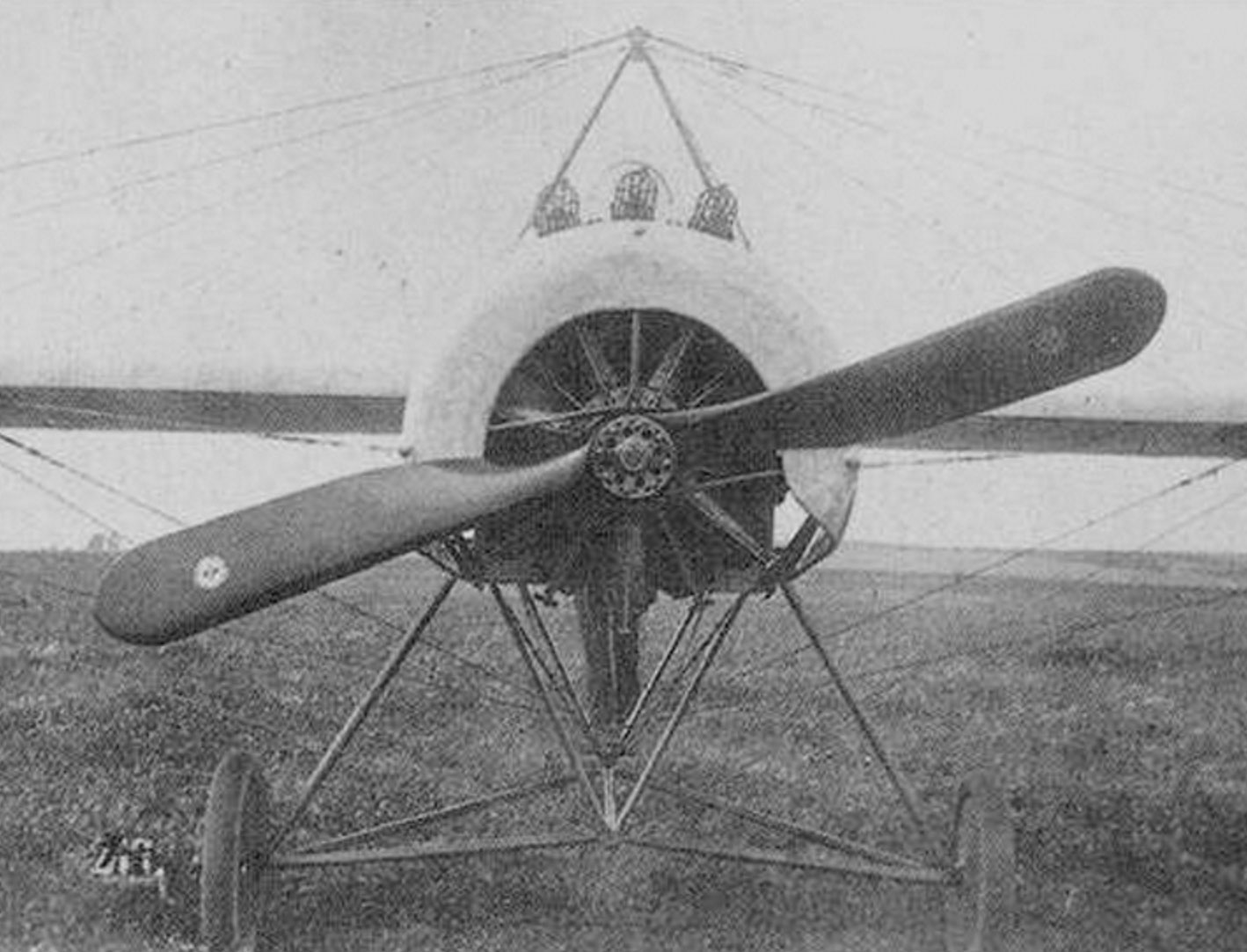
The infamous three-gun Fokker E.IV. The craft suffered more from the weight penalty than it gained in firepower. Immelmann is the ace most often said to have briefly flown such a plane in combat (possibly for kills 9-11 in March 1916), but most historians now believe no three-gun Eindecker ever left the factory. More “Until the Royal Flying Corps is in possession of a machine as good or better as the Fokker,” proclaimed British headquarters, “it seems a change in the tactics employed becomes necessary.” Meanwhile, however, Immelmann and Boelcke were discovering that the Fokker E.IV was, if more robust, inferior overall to the E.III. Twice the cylinders meant twice the weight, twice the unreliability and twice the torque effect on maneuverability, but not twice the performance. Flying above the lines on March 2, Immelmann had to dive away from an attacking Morane Saulnier L two seater, which was escorted by a Morane Saulnier N monoplane with its own forward-firing synchronized gun, flown by Sergeant Toné P.H. Bayetto. Unable to overtake them as they flew uncontested right over Douai, the Eagle of Lille “considered whether it would not be better for me to land, for I could simply do nothing with my engine.” He settled on cutting off the enemy’s retreat. As he put it, “Then the fun began.” The monoplane plunged to the attack. Dodging, Immelmann forced the two-seater down, but reported: “I could not make up the lost 500 meters of height with my bad engine and secondly I had a gun jam. So I let the monoplane buzz off in the direction of Lille and went home.” 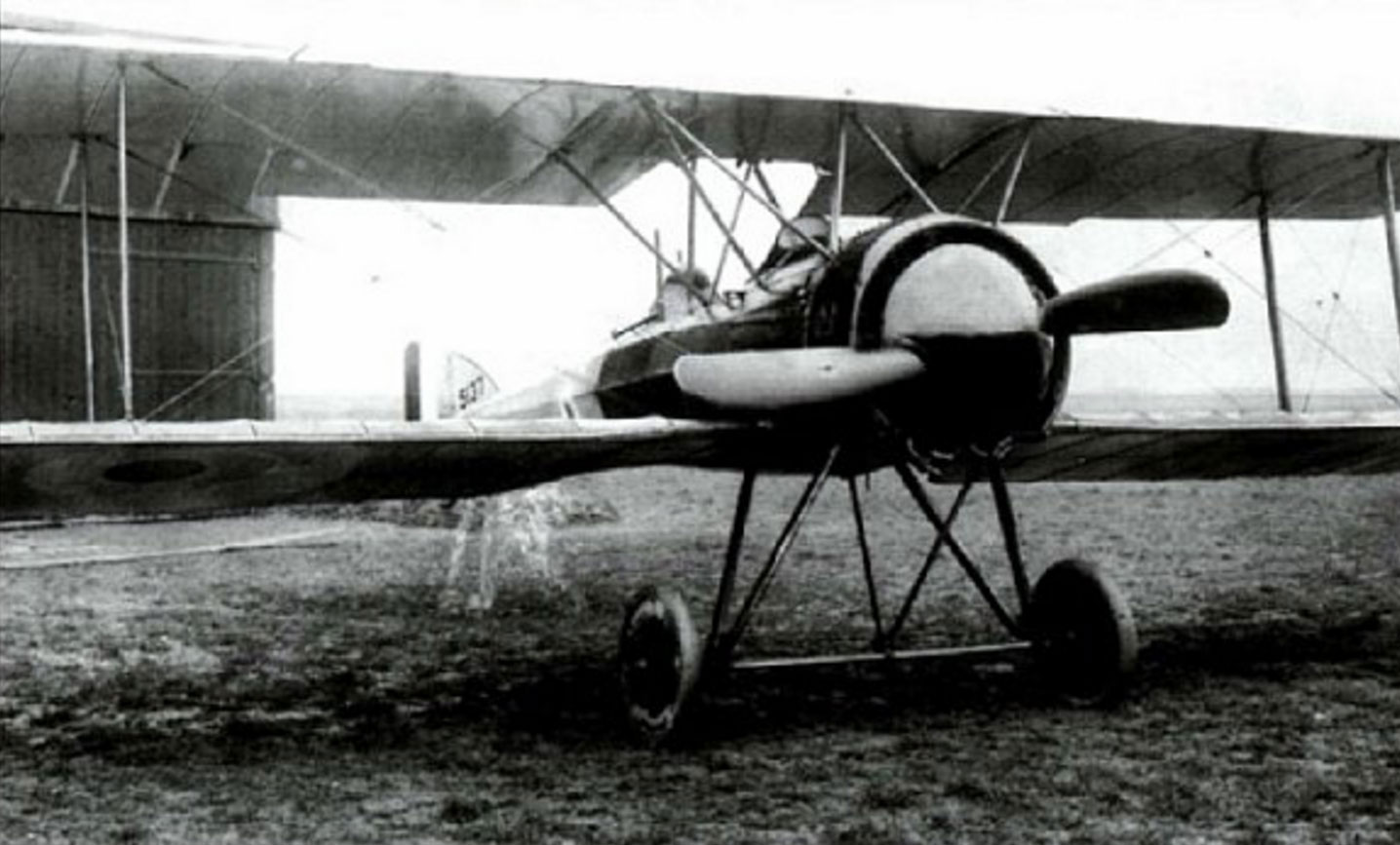
9th victory. On 2 March Immelmann forced No. 3 Sqn. Morane BB #5137 down near Somain. Observer 2Lt Herbert Frederick Birdwood, 22, was killed in the air and dropped his machine gun, which was found several miles away. Pilot 2Lt Charles Walter Palmer, 24, was wounded in the foot. According to Immelmann he remarked upon capture, “Well, if I have been shot down, at least I am glad Immelmann is my conqueror.” German doctors amputated Palmer’s foot, but he died of blood poisoning on 29 March. See also this view. 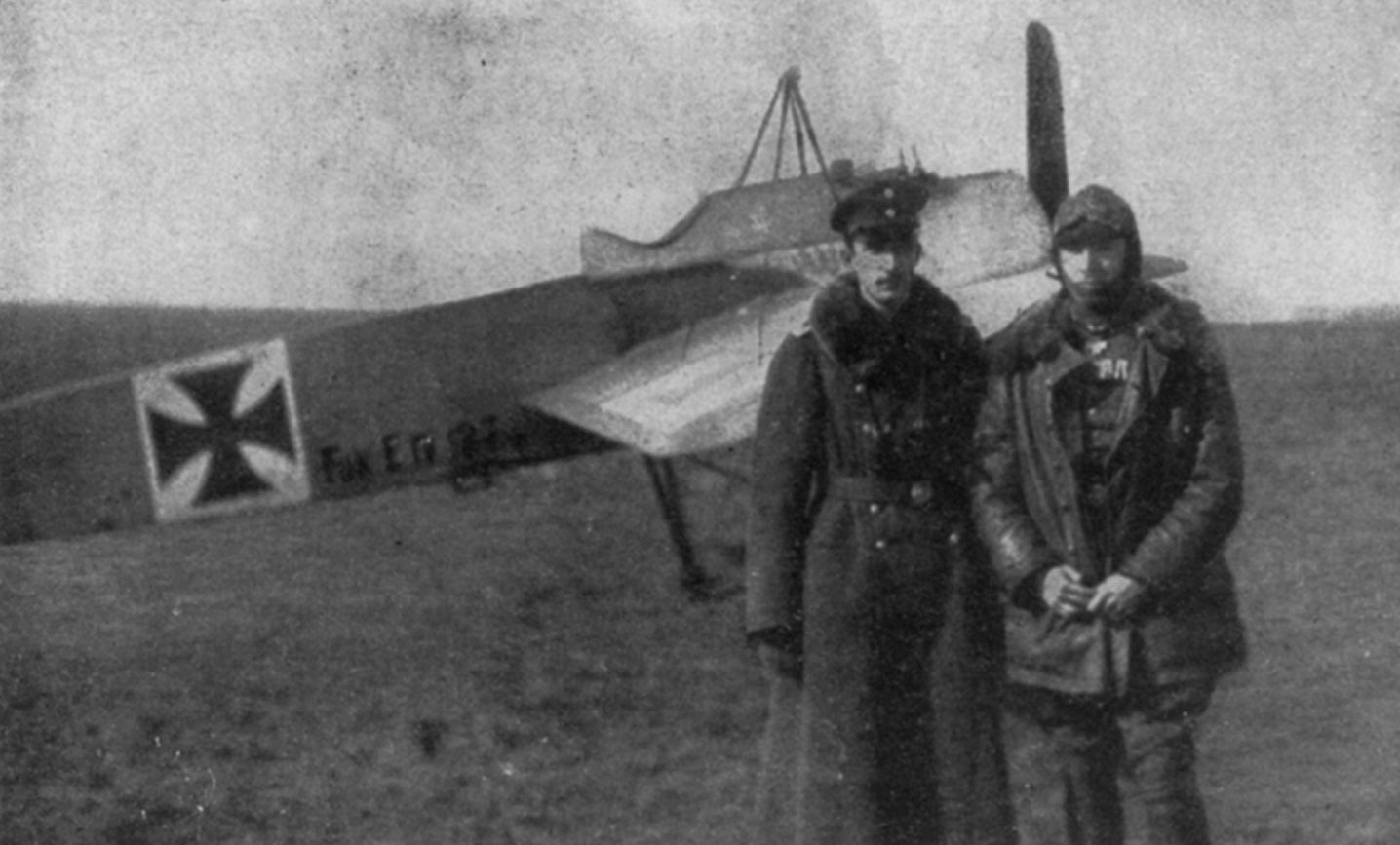
Early March, 1916. Immelmann with Crown Prince Boris of Bulgaria (later Tsar Boris III). Of interest here is the cockpit/gun fairing on the Eindecker E.IV in the background, which has had its streamlined “tail” removed, possibly to save weight. 
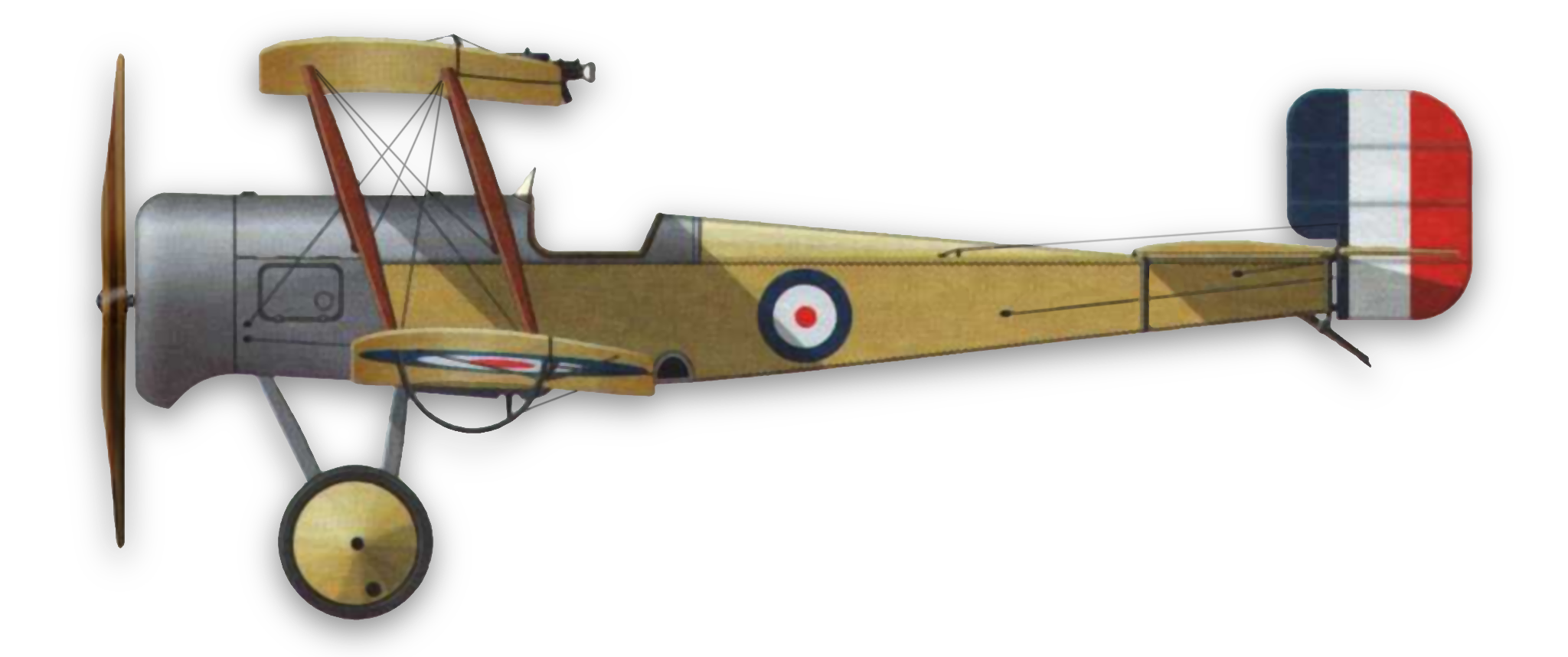
Bristol Scout Only three Scouts were ever lost on the German side of the lines. Two were downed by Immelmann Nevertheless, that March was the Eagle’s best month. He scored five victories, including a Bristol Scout around noon on the 13th and a B.E.2C that evening, his first double victory. A fellow pilot recalled, “At first, he was not pretentious. Later, after receiving many orders, he became a bit vain....He loved to have himself photographed each time he got a new medal.” Immelmann’s squadron mates began addressing him as “your exalted Majesty.” Still Boelcke kept pace. By month’s end their scores stood even, at 13. 
Airco DH.2, No. 24 Sqn., RFC. #5598 was flown by Lt. John Oliver Andrews, who along with Lt. Neville Philip Manfield nearly shot Immelmann down on April 25, 1916. Manfield was in turn shot down and killed by Boelcke on Sept. 9th in D H.2 #7842 near Thiepval, southwest of Bapaume. Two days after Easter Immelmann took on a pair of the new Airco DH.2 pusher biplanes of No. 24 Squadron, the Royal Flying Corps’ first all-fighter unit. He started out with a height advantage, but quickly found himself hard pressed: “The two worked splendidly together in the course of the fight and put eleven shots into my machine. The petrol tank, the struts on the fuselage, the undercarriage and the propeller were hit. I could only save myself by a nose dive of 1,000 meters. Then at last the two left me alone. It was not a nice business.” Fellow pilots noted their ace had by this time lost some of the spring in his step, one writing he’d become “a bundle of nerves lately.” Immelmann also fell behind in his letter writing, and only second hand accounts survive of his final weeks. 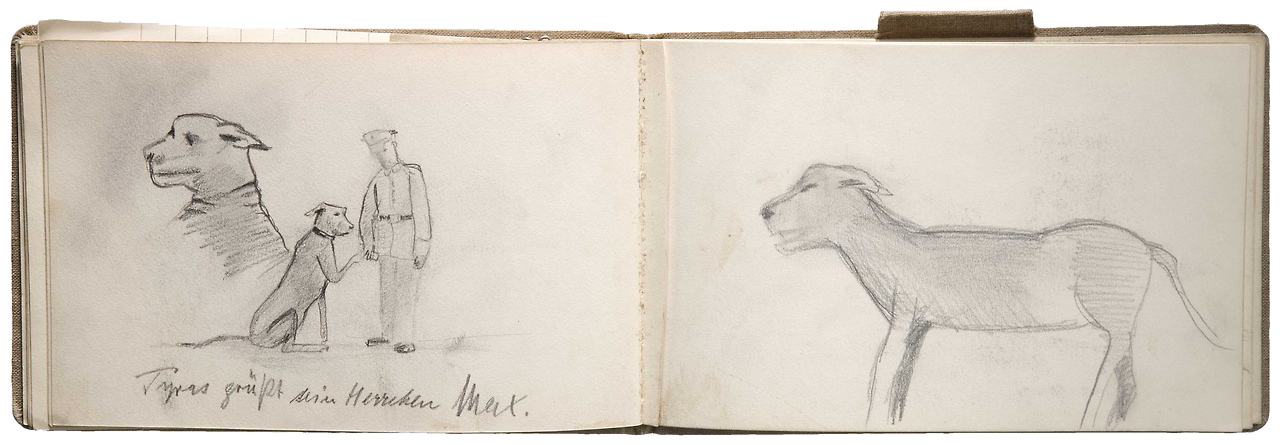
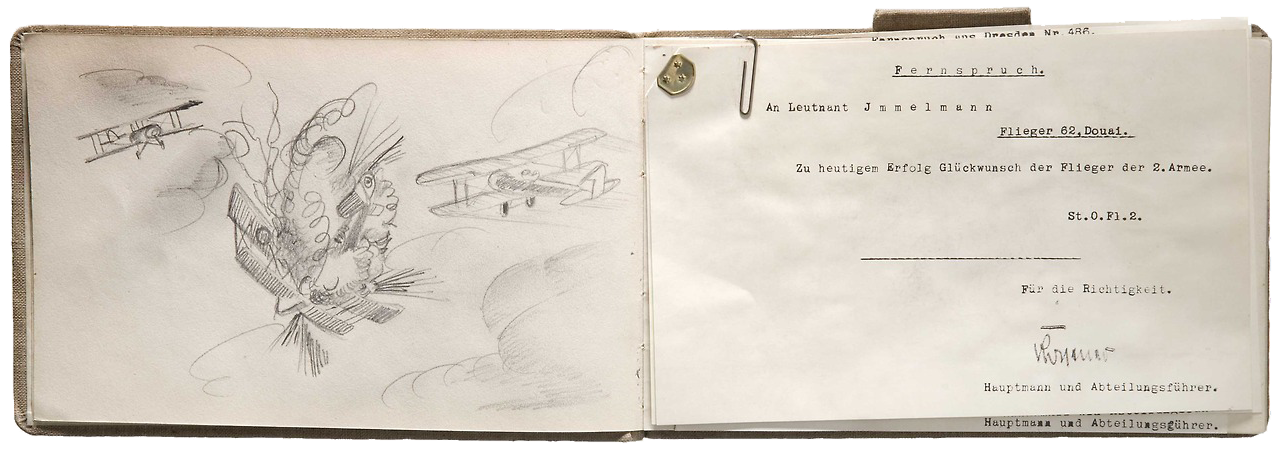
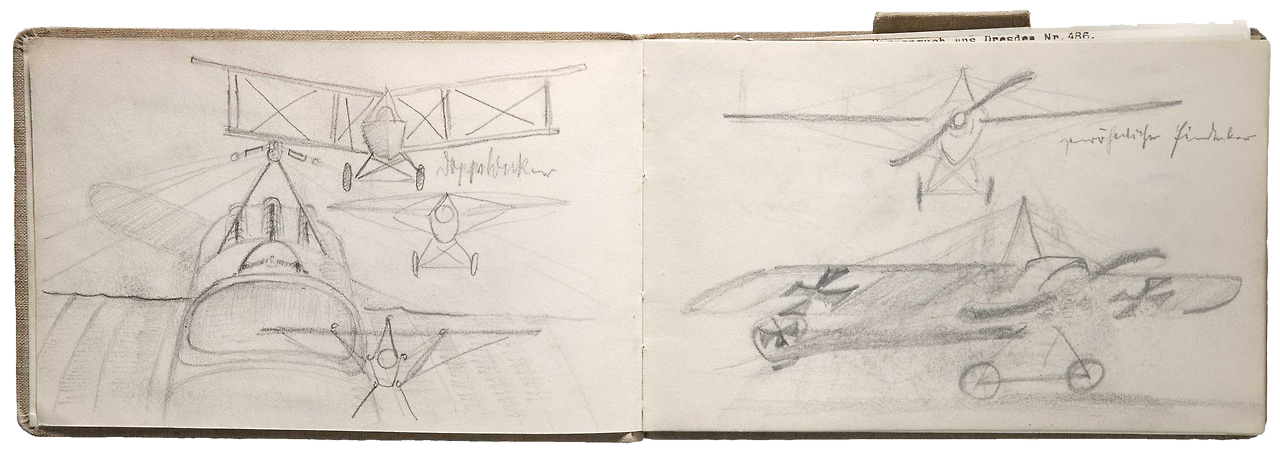
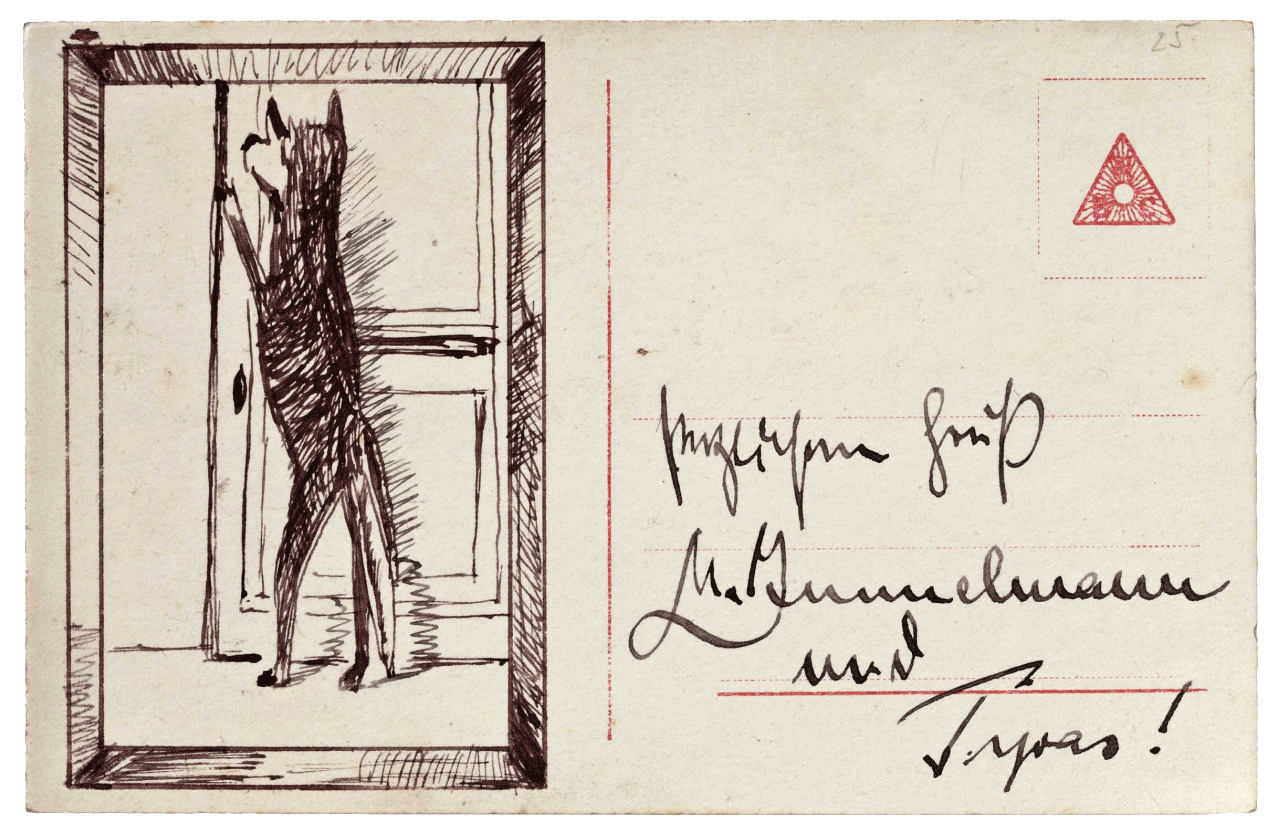
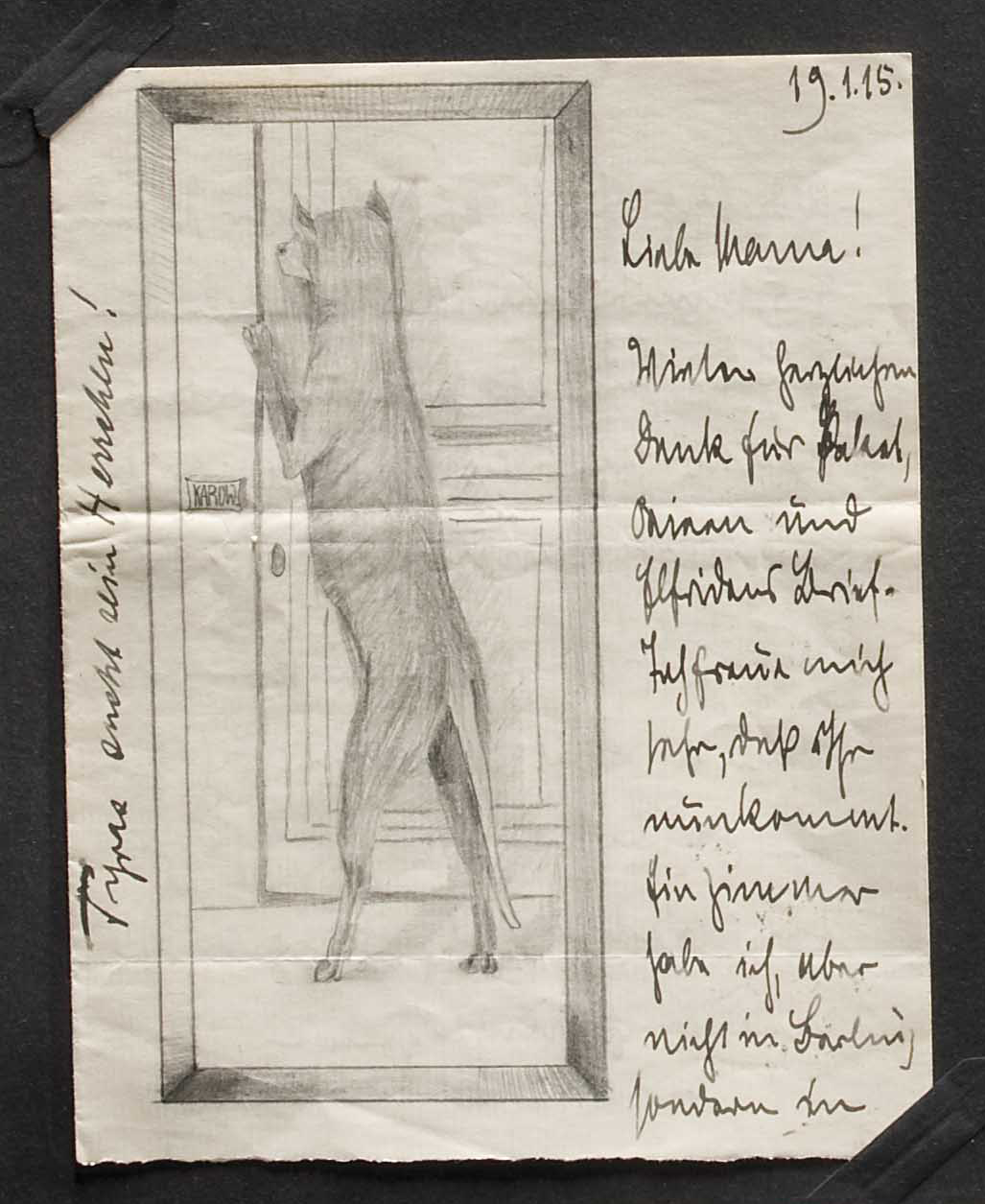
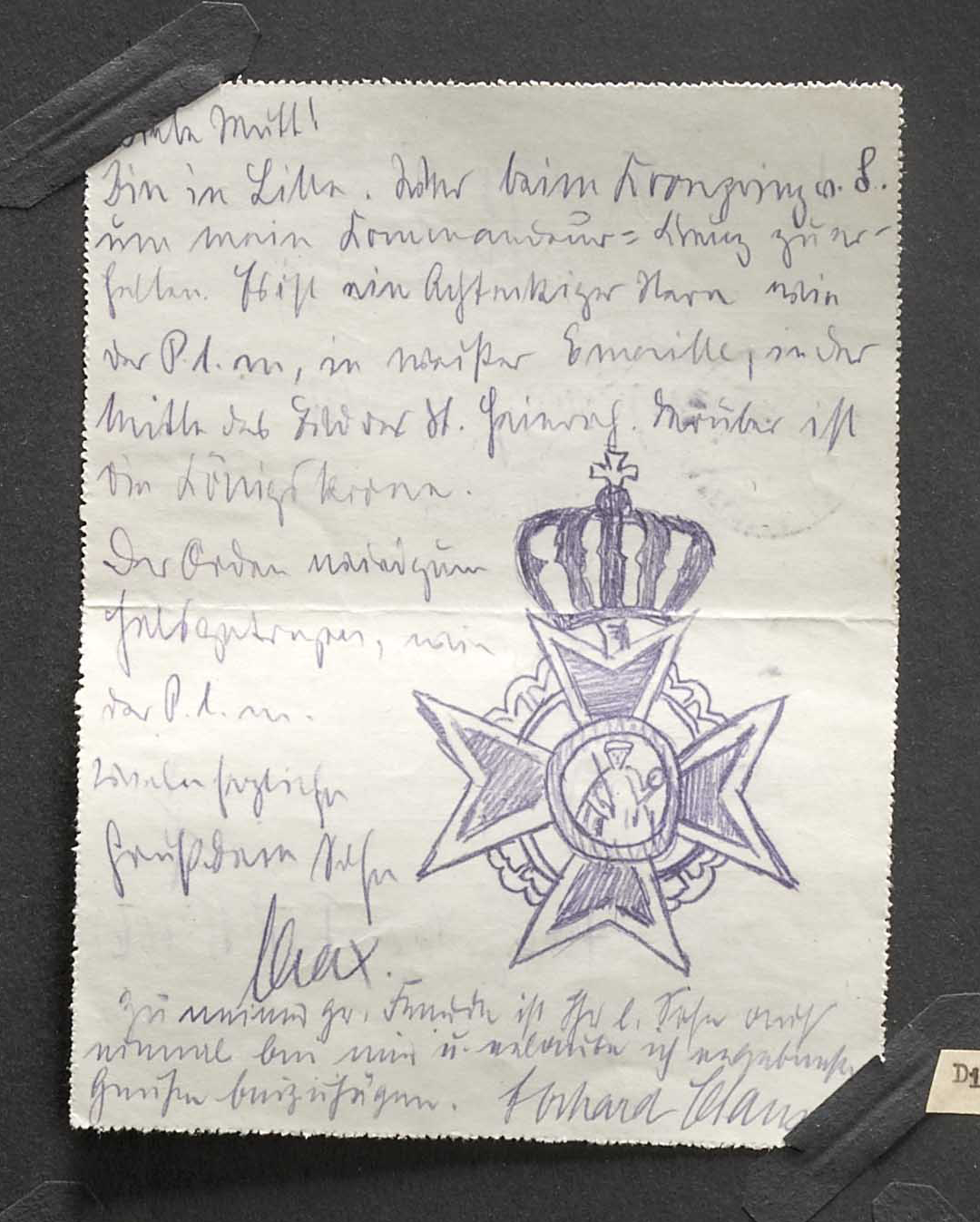
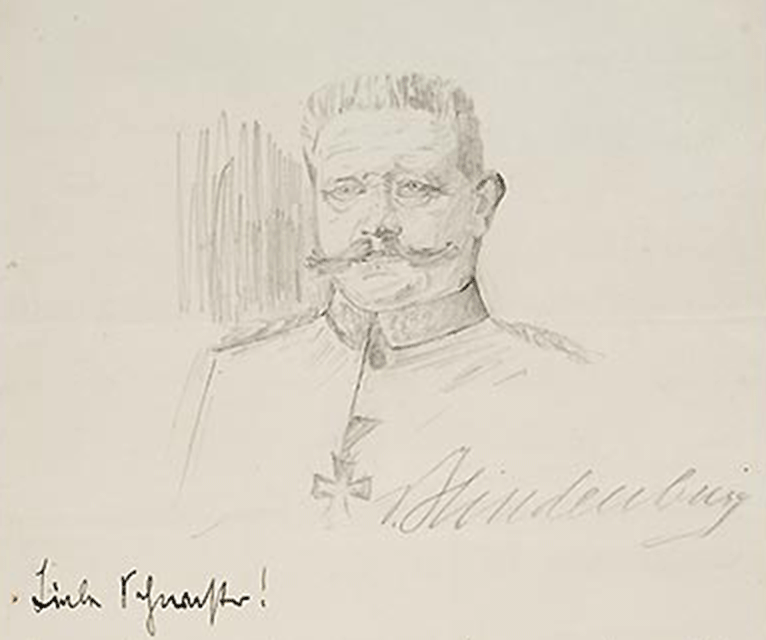
       
On the last day of May, leading three Eindeckers against seven Vickers between Bapaume and Cambrai, Immelmann had let off a long burst of fire when his E.IV began vibrating, almost out of control. He cut the fuel and ignition and, as the 14 cylinder rotary spun down, saw that his synchronizer gear had malfunctioned. Half a propeller blade was gone, sawed off by his own guns, and the lopsided prop had shaken the Oberursel almost out of its nacelle. Nose heavy, the Fokker started down. Immelmann barely managed to crash land beside the Cambrai–Douai road. It was no isolated incident; while test flying a three-gun E.IV, Tony Fokker himself almost shot off his own prop. But with the Allies deploying dedicated fighter units, Immelmann and Boelcke undertook—against opposition from their superiors—to have Germany follow suit. Immelmann, now a triple ace, was tapped to lead one of the first Jagdstaffeln (fighter squadrons), but it was not to be. Late on the afternoon of Sunday, June 18, Immelmann led four Eindeckers in pursuit of four British F.E.2b two-seat pushers of No. 25 Squadron. With one machine gun firing forward and another mounted high to fire backward over the upper wing and prop, the “Fee” was no easy prey. Immelmann succeeded in forcing one down near Arras, but only after his E.IV took serious hits to its struts and wings. It was still undergoing repairs at dusk when 25 Squadron sent another flight over the lines. In a fateful decision, Immelmann followed his men up in a reserve E.III, arriving late to the battle. 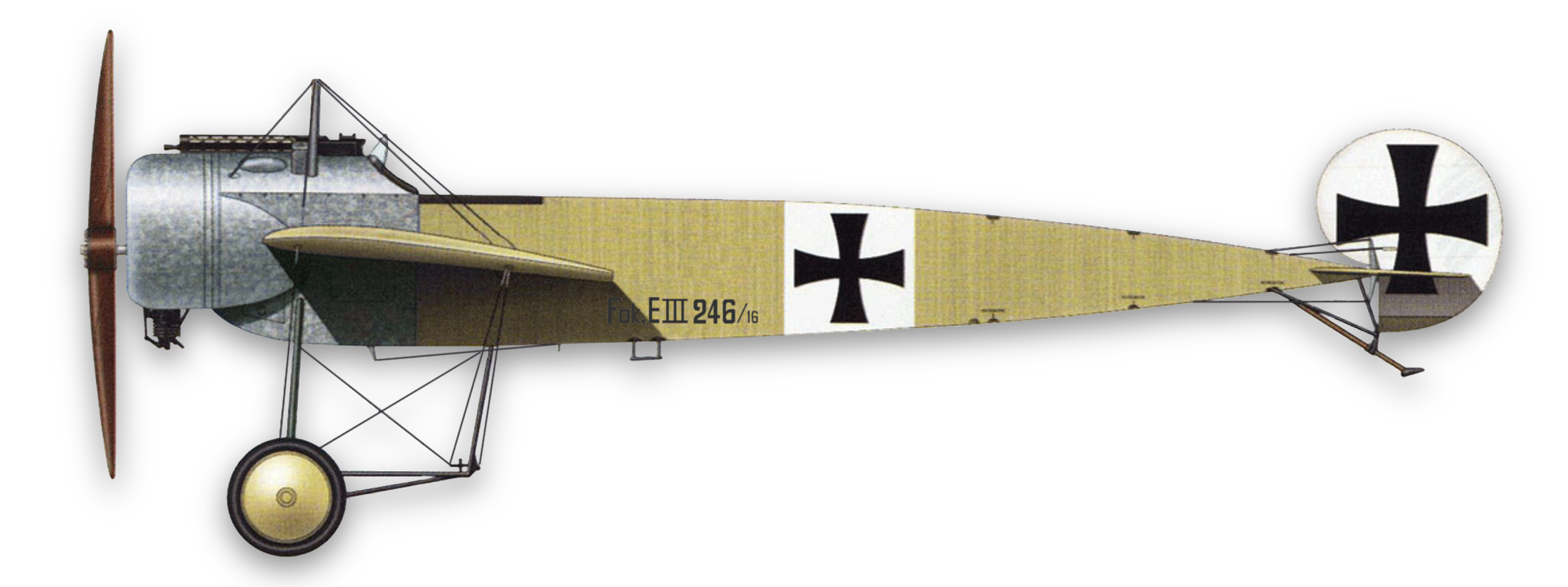
Fokker E.III #246/16, in which Immelmann lost his life A major dogfight had developed a mile or more above Loos. Four of Immelmann’s squadron mates were mixing it with four Fees. To the northeast, two Fokkers were tangling with four British planes, with two more Eindeckers hurrying toward them to even things up. Adding to the confusion, German flak batteries were pumping shells up into the melee. Shooting off a white flare to signal the anti-aircraft guns to hold fire, the Eagle of Lille plunged to attack an F.E.2b, rattling off a long stream of shots. His 17th victory fell away in a steep dive, to land behind German lines with its pilot mortally wounded. 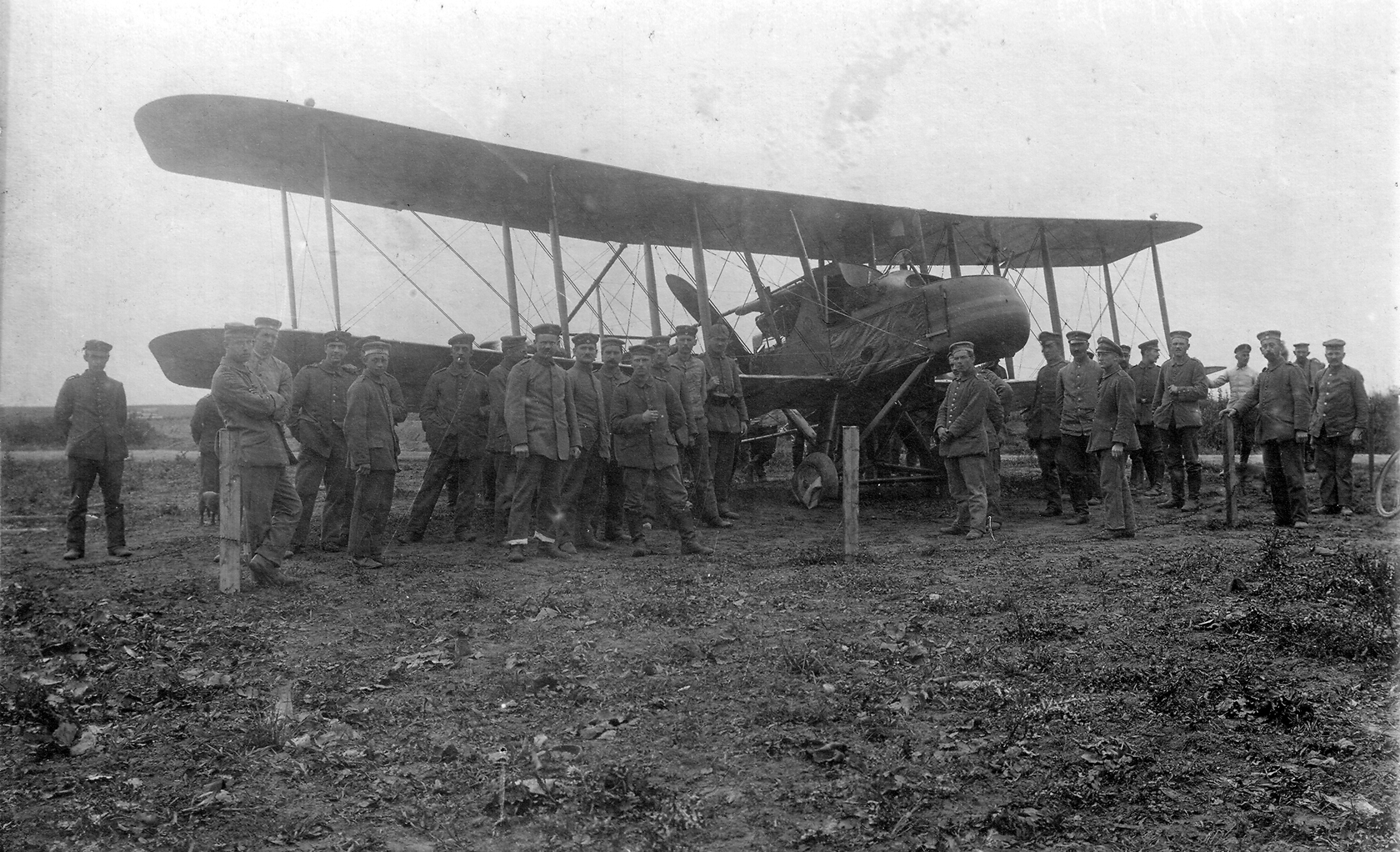
Last victory. FE2b #4909 of No 25 Sqn, Immelmann’s 17th victory. (Initially credited to Lt. Max Mulzer as his fourth victory. On many lists Immelmann is not credited with his last two victories, both claimed on 18 June 1916.) 
The “Fee” was named Baby Mine. Pilot Lt J.R.B. Savage was mortally wounded in the encounter, but observer 2AM Robinson survived and was taken prisoner. At practically the same moment they went down, Immelmann himself was killed. Another Fee came down behind Immelmann. Pilot 2nd Lt. G.R. McCubbin reported: “By this time I was very close to the Fokker and he apparently realized we were on his tail, and he immediately started to do what I expect was the beginning of an ‘Immelmann’ turn. As he started to turn we opened fire.” Observer Corporal J.H. Waller let go a burst from his forward Lewis gun as Immelmann’s Eindecker crossed their nose. “The Fokker immediately got out of control,” reported McCubbin, “and went down to earth.” 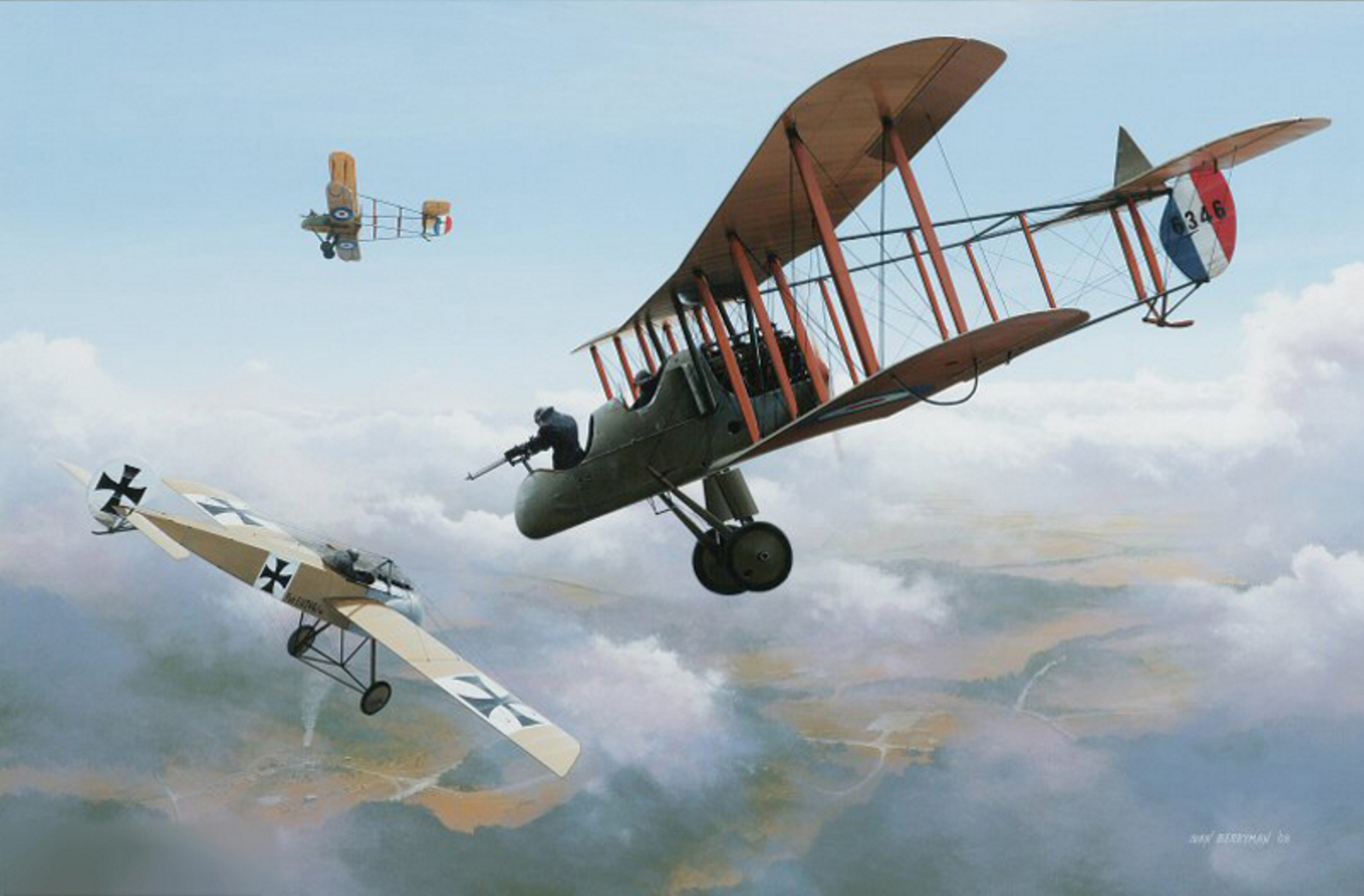
Immelmann’s Last Flight by Ivan Berryman One of Immelmann’s squadron mates testified that his leader attempted to climb as if to rejoin the fight, but something clearly wasn’t right. The Fokker pitched up and stalled over its left wing, bucking and flapping. Witnesses saw its fuselage break off behind the cockpit. As it began its death dive, both wings tore away as well. The engine and cockpit fell more than a mile. Immelmann’s remains were recognized only by his monogrammed kerchief and the Blue Max at his throat. 





      
2nd Lt. George Reynolds McCubbin, piloting No. 25 Sqn. FE2B #6346, won the DSO, “For conspicuous gallantry and skill. Seeing one of our machines about to engage two Fokkers he at once entered the fight, and his observer shot down one Fokker, which crashed to the ground. On another occasion when returning from a bombing raid he saw one of our machines being followed by a Fokker. He recrossed the lines to attack and his observer shot down the Fokker. Although very badly wounded in the arm he successfully landed his machine well behind our lines.” (This combat occurred on June 26th, little over a week after Immelmann was downed, and put McCubbin in the hospital.) His observer, Cpl. James Henry Waller (who actually pulled the trigger on Immelmann) received the Russian Medal of St George, 1st Class. He was one of the first great aces to die in combat. Germany struggled to come to grips with his loss. Experts claimed his Eindecker had been hit by friendly anti-aircraft fire, or that his synchronizer gear had malfunctioned again (one of the prop blades appeared to be sawed off), that the less-sturdy E.III had been unable to withstand the resultant shaking—anything but admit their hero had fallen to the enemy. For their part, the British simply credited the kill to McCubbin and Waller, who said, “It is quite on the cards that our bullets not only got him, but his prop as well.” 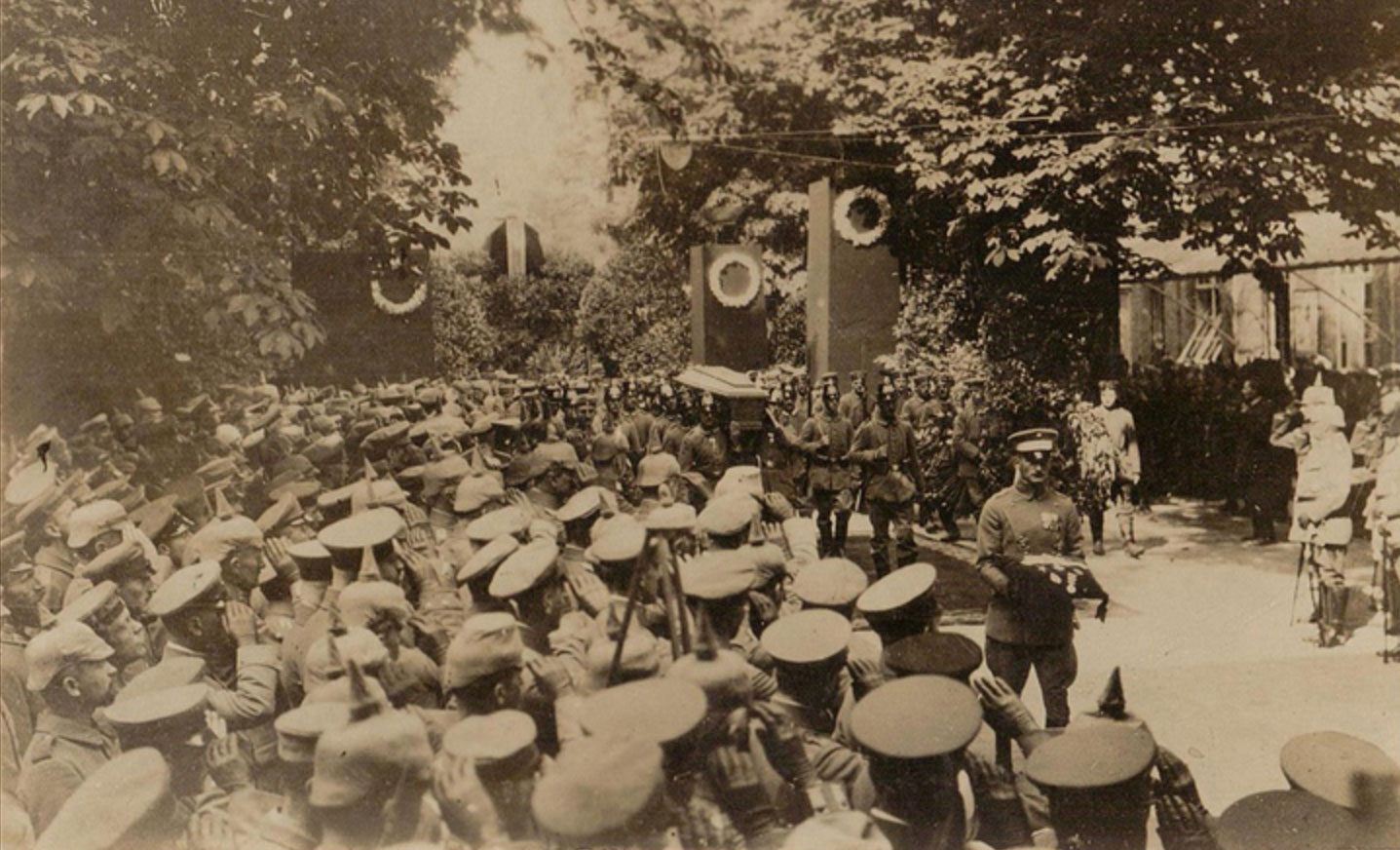
Max Immelmann was given a state funeral and buried in Dresden, his home town. His body was later exhumed, however, and cremated in the Tolkewitz Crematorium. Some 200 German pilots flew Fokker Eindeckers and only three or four (e.g. Max Ritter von Mulzer, Rudolph Berthold, Ernst Freiherr von Althaus) came close to Boelcke and Immelmann in their scores. “Immelmann lost his life by a silly chance,” declared Boelcke, who was transferred to the Eastern Front to spare his country another such loss. Within the year he would raise his score to 40, only to die in a midair collision with one of his own men. Even more than Boelcke, Immelmann has come to be identified with the Fokker Eindecker, in which he rose and fell. Perhaps he had just been lucky to fly it during its brief supremacy, but then so did many men, without achieving as much. “He had it much more difficult than later fighter pilots,” a fellow pilot recalled of Max Immelmann after the war, “...because in 1915–16 there was much less aerial activity. His number of victories was not as large...but they were harder earned.”
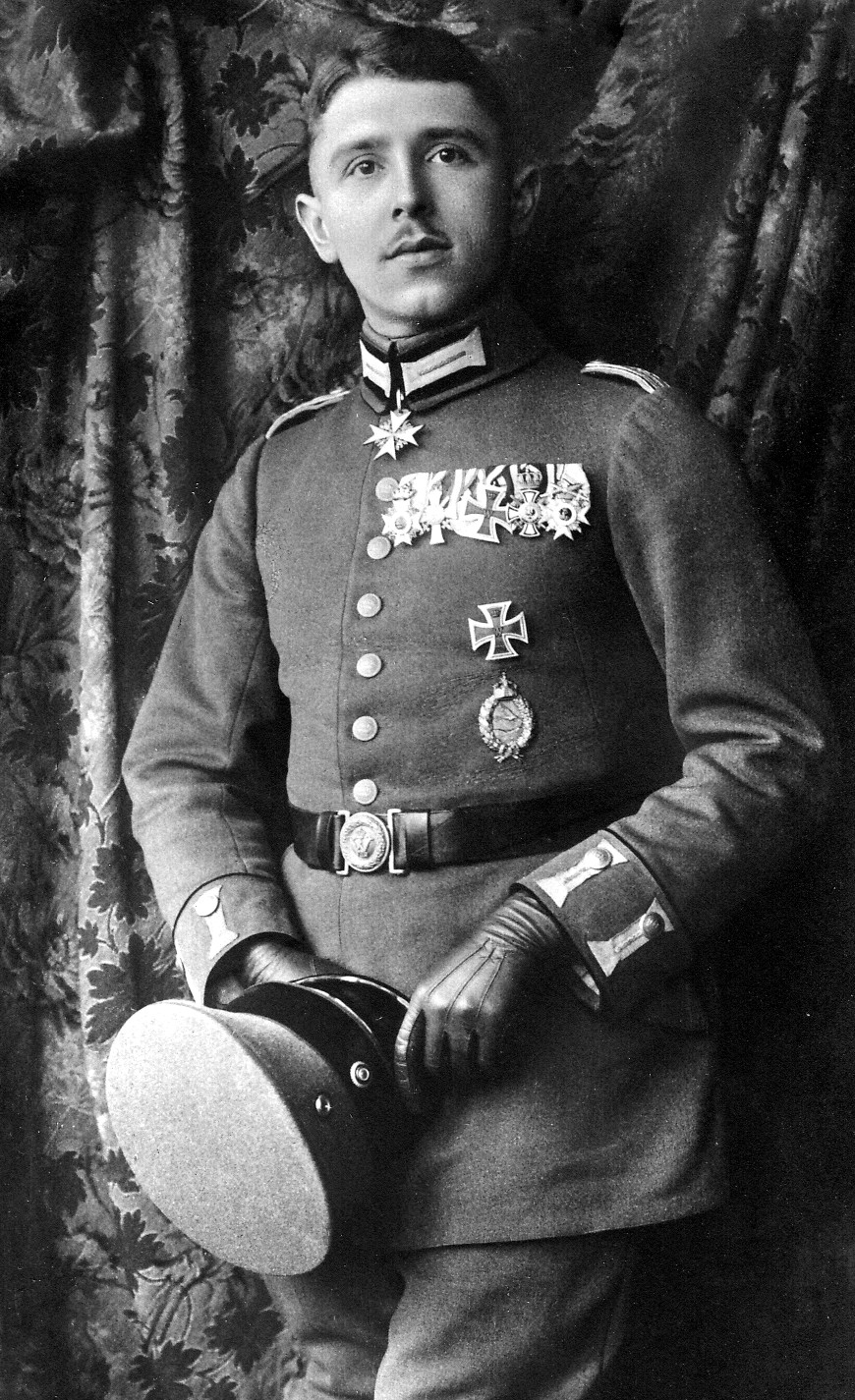
Oberleutnant Max Immelmann
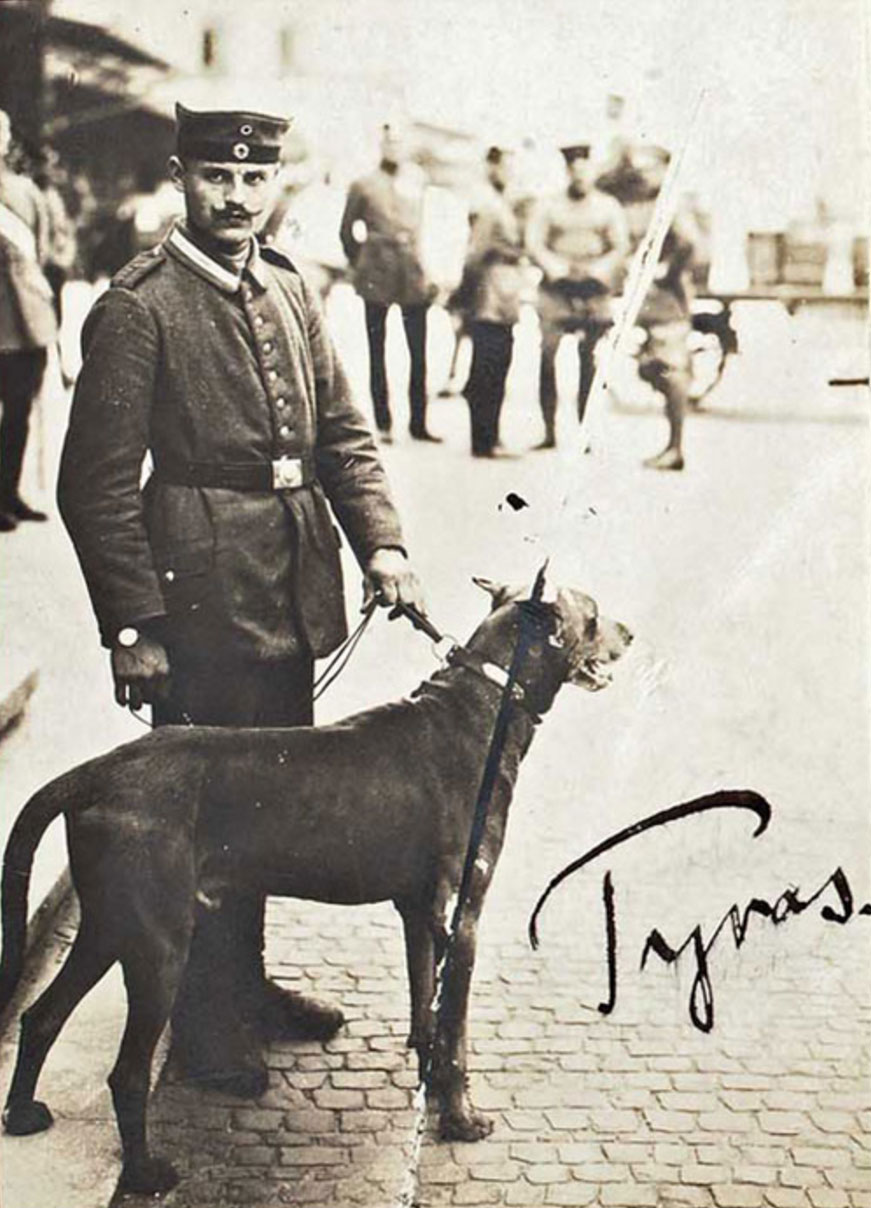
Photo, with cracked plate, said to be taken at Max Immelmann’s funeral procession. Bibliography
Brannon, D. Edgar. Fokker Eindecker in Action. Carrollton, TX: Squadron/Signal Publications, 1996. ISBN 0897473515
About the authorAuthor/illustrator/historian Don Hollway has been published in Aviation History, Excellence, History Magazine, Military Heritage, Military History, Civil War Quarterly, Muzzleloader, Porsche Panorama, Renaissance Magazine, Scientific American, Vietnam, Wild West, and World War II magazines. His work is also available in paperback, hardcover and across the internet, a number of which rank extremely high in global search rankings. More from Don Hollway:Comments loading....
|
